| Oracle Fusion Middleware Developer's Guide for Oracle TopLink 11g Release 1 (11.1.1) Part Number B32441-03 |
|
|
View PDF |
| Oracle Fusion Middleware Developer's Guide for Oracle TopLink 11g Release 1 (11.1.1) Part Number B32441-03 |
|
|
View PDF |
This chapter describes how to configure TopLink project options common to two or more project types.
This chapter includes the following sections:
Configuring Unit of Work Cache Isolation at the Descriptor Level
Configuring Cache Coordination Change Propagation at the Descriptor Level
Configuring Cache Existence Checking at the Descriptor Level
Configuring Inheritance for a Child (Branch or Leaf) Class Descriptor
Configuring Inheritance Expressions for a Parent (Root) Class Descriptor
Table 119-1 lists the types of TopLink descriptors that you can configure and provides a cross-reference to the type-specific chapter that lists the configurable options supported by that type.
Table 119-1 Configuring TopLink Descriptor
| If you are creating... | See... |
|---|---|
|
Chapter 26, "Configuring an Object-Relational Data Type Descriptor" |
|
Table 119-2 lists the configurable options shared by two or more TopLink descriptor types.
For more information, see the following:
Table 119-2 lists the configurable options shared by two or more TopLink descriptor types. In addition to the configurable options described here, you must also configure the options described for the specific Descriptor Types, as shown in Table 119-1.
Table 119-2 Common Descriptor Options
A primary key is a unique identifier (made up of one or more persistent attributes) that distinguishes one instance of a class from all other instances of the same type. You use primary keys to define relationships and to define queries.
For the descriptors shown in Table 119-3, you must configure a primary key and you must ensure that your class contains one or more persistent fields suitable for this purpose.
Table 119-3 summarizes which descriptors support primary keys.
Table 119-3 Descriptor Support for Primary Keys
| Descriptor | How to Use Oracle JDeveloper | How to Configure Primary Keys Using TopLink Workbench |
How to Configure Primary Keys Using Java |
|---|---|---|---|
|
Relational DescriptorsFoot 1 |
|
|
|
|
Object-Relational Data Type Descriptors |
|
|
|
|
EIS DescriptorsFoot 2 |
|
|
|
|
XML Descriptors |
|
|
|
Footnote 1 Relational class descriptors only (see Section 22.2.1.1, "Creating Relational Class Descriptors").
Footnote 2 EIS root descriptors only (see Section 75.2.1.1, "EIS Root Descriptors").
For a relational class (non-aggregate) descriptor, choose any unique database field or set of unique database fields from the descriptor's associated table (see Section 23.2, "Configuring Associated Tables").
For an EIS root descriptor (see Section 76.6, "Configuring an EIS Descriptor as a Root or Composite Type"), choose any unique attribute or text node or set of unique attributes or text nodes from the descriptor's schema context (see Section 76.2, "Configuring Schema Context for an EIS Descriptor").
To associate a descriptor with one or more primary keys, use this procedure:
Select a descriptor in the Navigator. Its properties appear in the Editor.
Click the Descriptor Info tab. The Descriptor Info tab appears.
Figure 119-1 Descriptor Info Tab, Primary Key Options
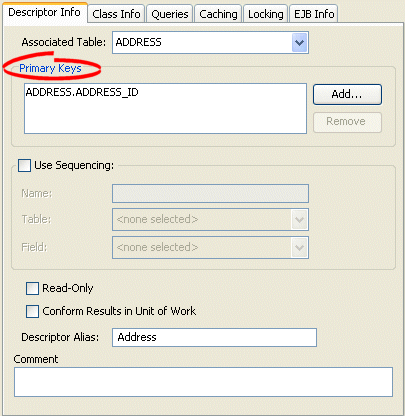
Use this table to enter data in Primary Keys field on the descriptor's Descriptor Info tab to specify the primary key(s):
| Field | Description |
|---|---|
| Primary Keys | To specify the primary keys for the table, click Add in order to do the following:
To remove a primary key, select the key and click Remove. |
You can use Java to configure primary keys for the following:
Use ClassDescriptor method addPrimaryKeyFieldName to specify the primary key field of the descriptor's table. This should be called for each field that makes up the primary key of the table.
If the descriptor has more than one table, and all other tables have the same primary key, use the ClassDescriptor method addPrimaryKeyFieldName to specify the the primary key in the first table.
If the descriptor has more than one table, and each table has a different primary key, use ClassDescriptor method addForeignKeyFieldNameForMultipleTable to map the source foreign key field name to target primary key field name.
Use EISDescriptor method addPrimaryKeyFieldName to specify the primary key field of the descriptor's class. Call this method for each field that makes up the primary key.
You can configure a relational class or EIS root descriptor as read-only. This indicates that instances of the reference class will never be modified.
Read-only descriptors are usually used within a unit of work as a performance gain, because there is no need to register, clone, and merge the read-only classes. For more information, see Chapter 113, "Introduction to TopLink Transactions".
In a CMP project, you can declare an entity bean as read-only within the TopLink deployment XML file. For more information, see Section 119.3.1, "How to Use Read-Only EJB CMP Entity Beans".
Table 119-4 summarizes which descriptors support read-only configuration.
Table 119-4 Descriptor Support for Read Only
| Descriptor | How to Use Oracle JDeveloper | How to Configure Read-Only Descriptors Using TopLink Workbench |
How to Configure Read-Only Descriptors Using Java |
|---|---|---|---|
|
Relational DescriptorsFoot 1 |
|
|
|
|
Object-Relational Data Type Descriptors |
|
|
|
|
EIS DescriptorFoot 2 |
|
|
|
|
XML Descriptors |
|
|
|
Footnote 1 Relational class descriptors only (see Section 22.2.1.1, "Creating Relational Class Descriptors").
Footnote 2 EIS root descriptors only (see Section 75.2.1.1, "EIS Root Descriptors")
Note:
Relational aggregate and EIS composite descriptors get their read-only setting from their owner.TopLink can declare an entity bean with container-managed persistence as read-only. This ensures that the entity bean cannot be modified and allows TopLink to optimize unit of work performance.
If an attempt is made to modify a read-only entity bean (create, update, or remove), TopLink immediately throws a javax.ejb.EJBException: TopLink does not wait until the transaction commits.
If an attempt is made to change a CMR field on a read-only entity bean, TopLink throws a javax.ejb.EJBException.
When TopLink is configured as the OC4J persistence manager, the TopLink read-only bean configuration replaces the OC4J READ-ONLY CMP concurrency mode.
To configure a descriptor as read-only use this procedure:
Select a descriptor in the Navigator. Its properties appear in the Editor.
Click the Descriptor Info tab. The Descriptor Info tab appears.
Figure 119-2 Descriptor Info Tab, Read Only Option
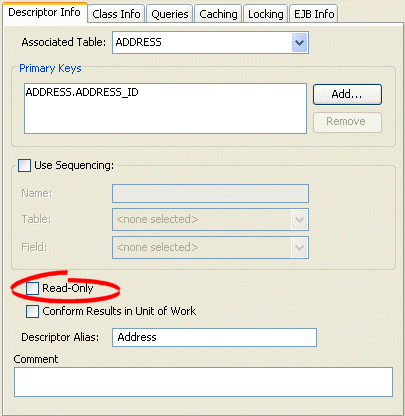
Specify whether this descriptor is read-only or not.
Use ClassDescriptor method setReadOnly.
Conforming is a query feature that lets you include new, changed, or deleted objects in queries within a unit of work prior to committing the transaction. This feature enables you to query against your relative logical or transaction view of a data source.
Table 119-5 summarizes which descriptors support descriptor level unit of work conforming.
Table 119-5 Descriptor Support for Unit of Work Conforming
| Descriptor | How to Use Oracle JDeveloper | How to Configure Unit of Work Conforming at the Descriptor Level Using TopLink Workbench |
How to Configure Unit of Work Conforming at the Descriptor Level Using Java |
|---|---|---|---|
|
Relational DescriptorsFoot 1 |
|
|
|
|
Object-Relational Data Type Descriptors |
|
||
|
EIS DescriptorsFoot 2 |
|
|
|
|
XML Descriptors |
Footnote 1 Relational class descriptors only (see Section 22.2.1.1, "Creating Relational Class Descriptors").
Footnote 2 EIS root descriptors only (see Section 75.2.1.1, "EIS Root Descriptors")
When you configure a descriptor to conform results in a unit of work, when you execute a query in the unit of work, TopLink filters the data source result set to the changes currently made in the unit of work. TopLink adds new or changed objects that correspond to the query's selection criteria and removes changed objects that no longer correspond to the query's selection criteria.
Note:
For EIS root descriptors, only deleted objects would be filtered, not new or changed objects.Conforming can reduce performance. Before you enable a descriptor for conforming, be aware of its limitations (see Section 115.4.1, "How to Use Conforming") and make sure that conforming is actually necessary.
For examples, see the following:
To conform a descriptor's results in a unit of work, use this procedure:
Select a descriptor in the Navigator. Its properties appear in the Editor.
Click the Descriptor Info tab. The Descriptor Info tab appears.
Figure 119-3 Descriptor Info Tab, Conform Results in Unit of Work Option
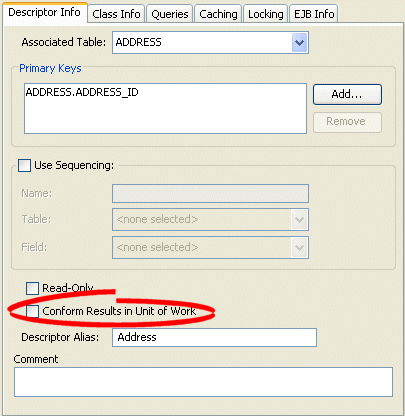
Enable or disable conforming: when enabled, this feature ensures that any queries for this descriptor will conform the data source result with the current changes in the unit of work. For more information, see Section 115.4.1, "How to Use Conforming".
Use ClassDescriptor method setShouldAlwaysConformResultsInUnitOfWork(true).
In EJB CMP, use the descriptor alias to specify the value of the ejb-jar.xml attribute abstract-schema-name. This is the logical name that is referenced in EJB QL queries. You should configure a descriptor alias for each entity bean with container-managed persistence. The descriptor alias defaults to the class name without a path information.
Table 119-6 summarizes which descriptors support descriptor alias configuration.
Table 119-6 Descriptor Support for Descriptor Alias Configuration
| Descriptor | How to Use Oracle JDeveloper | How to Configure Descriptor Alias Using TopLink Workbench |
How to Configure Descriptor Alias Using Java |
|---|---|---|---|
|
Relational Descriptors |
|
|
|
|
Object-Relational Data Type Descriptors |
|||
|
EIS DescriptorsFoot 1 |
|
|
|
|
XML Descriptors |
Footnote 1 EIS root descriptors only (see Section 75.2.1.1, "EIS Root Descriptors").
Note:
The alias is also used in JPA–it is the entity name. This is the logical name referenced in JP QL queries. It defaults to the class name without a path information.For more information, see "Introduction to EclipseLink JPA" chapter of EclipseLink Developer's Guide at http://wiki.eclipse.org/Introduction_to_EclipseLink_JPA_%28ELUG%29.
For more information, see the following:
To specify a descriptor alias, use this procedure:
In the Navigator, select a descriptor.
Click the Descriptor Info tab in the Property window.
Figure 119-4 Descriptor Info Tab, Descriptor Alias Field
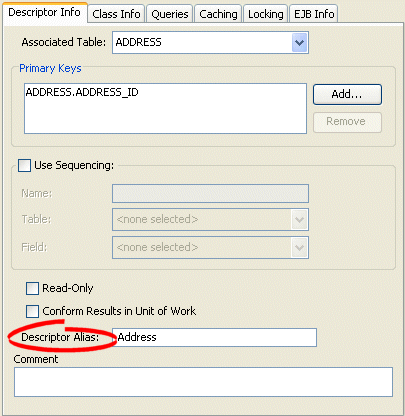
In the Descriptor Alias field, enter an alias for this descriptor. For more information, see Section 119.5, "Configuring Descriptor Alias".
Use ClassDescriptor method setAlias passing in the descriptor alias as a String.
You can define a free-form textual comment for each descriptor. You can use these comments however you whish: for example, to record important project implementation details such as the purpose or importance of a descriptor.
Comments are stored in the TopLink Workbench project, in the TopLink deployment XML file. There is no Java API for this feature.
Table 119-7 summarizes which descriptors support descriptor comment configuration.
Table 119-7 Descriptor Support for Descriptor Comment Configuration
| Descriptor | How to Use Oracle JDeveloper | How to Configure Descriptor Comments Using TopLink Workbench |
How to Use Java |
|---|---|---|---|
|
Relational Descriptors |
|
||
|
Object-Relational Data Type Descriptors |
|||
|
EIS Descriptors |
|
||
|
XML Descriptors |
|
To create a comment for a descriptor, use this procedure:
In the Navigator, select a descriptor.
Click the Descriptor Info tab in the Property window.
Figure 119-5 Descriptor Info Tab, Comment Field
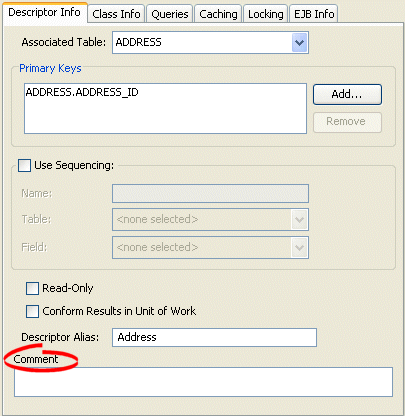
In the Comment field, enter a description of this descriptor.
A named query is a TopLink query that you create and store, by name, in a descriptor's DescriptorQueryManager for later retrieval and execution. Named queries improve application performance because they are prepared once and they (and all their associated supporting objects) can be efficiently reused thereafter making them well suited for frequently executed operations.
If a named query is global to a Class, configure it at the descriptor level. Alternatively, you can configure a named query at the session level (see Section 89.13, "Configuring Named Queries at the Session Level").
Use named queries to specify SQL, EJB QL, or TopLink Expression queries to access your data source.
For EJB CMP entity bean descriptors, you must define a named query for every finder defined for the corresponding entity bean.
Note:
You can also use named queries in JPA (see "Using EclipseLink JPA Extensions for Stored Procedure Query" section of EclipseLink Developer's Guide athttp://wiki.eclipse.org/Using_EclipseLink_JPA_Extensions_%28ELUG%29#Using_EclipseLink_JPA_Extensions_for_Stored_Procedure_Query). Because the scope of JPA named queries is global to the session, ensure that each named query has a unique name.Using Oracle JDeveloper or TopLink Workbench, you can configure named queries for a subset of query types and store them in a descriptor's DescriptorQueryManager (see Section 119.7.1, "How to Configure Named Queries at the Descriptor Level Using TopLink Workbench").
Using Java, you can create named queries for all query types and store them in a descriptor's DescriptorQueryManager (see Section 119.7.2, "How to Configure Named Queries at the Descriptor Level Using Java").
Table 119-4 summarizes which descriptors support named query configuration.
Table 119-8 Descriptor Support for Named Queries
| Descriptor | How to Use Oracle JDeveloper | How to Configure Named Queries at the Descriptor Level Using TopLink Workbench |
How to Configure Named Queries at the Descriptor Level Using Java |
|---|---|---|---|
|
Relational DescriptorsFoot 1 |
|
|
|
|
Object-Relational Data Type Descriptors |
|
|
|
|
EIS DescriptorFoot 2 |
|
|
|
|
XML Descriptors |
|
|
|
Footnote 1 Relational class descriptors only (see Section 22.2.1.1, "Creating Relational Class Descriptors").
Footnote 2 EIS root descriptors only (see Section 75.2.1.1, "EIS Root Descriptors").
For CMP projects, the ejb-jar.xml file stores query lists. You can define the queries in the file, and then read them into Oracle JDeveloper or TopLink Workbench, or define them on the Queries tab and write them to the file. See Section 19.7, "Working with the ejb-xml.File" for more information.
After you create a named query, you can execute it by name and class on the TopLink session (see Section 109.3, "Using Named Queries").
For more information about named queries, see Section 108.8, "Named Queries".
To create a named query, use this procedure
In the Navigator, select a descriptor. Its properties appear in the Editor.
Click the Queries tab in the Editor. The Queries tab appear with three additional tabs.
Click the Named Queries tab in the Queries tab. The Named Queries tab appears.
Figure 119-6 Queries Tab–Named Queries Subtab
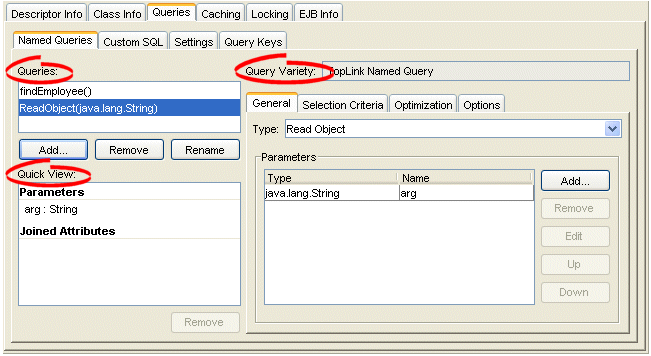
Use the following information to complete each field on this tab:
| Field | Description |
|---|---|
| Queries | Lists the existing queries for this descriptor.
|
| Query Variety | Displays the variety of the currently selected query (see Section 119.7.1.1, "Adding Named Queries"). |
| Quick View | Lists the parameters and joined attributes defined for the query.
Clicking on a heading in the Quick View area selects the corresponding subtab. You can also remove parameters or attributes from the Quick View area by selecting the item and clicking Remove. |
The Named Queries tab includes the following subtabs:
General–See Section 119.7.1.2, "Configuring Named Query Type and Parameters".
Selection Criteria–See Section 119.7.1.3, "Configuring Named Query Selection Criteria".
Order–This tab appears for ReadAllQuery queries only. See Section 119.7.1.4, "Configuring Read All Query Order".
Optimization–See Section 119.7.1.5, "Configuring Named Query Optimization".
Attributes–This tab appears for ReportQuery queries only. See Section 119.7.1.6, "Configuring Named Query Attributes".
Group/Order–This tab appears for ReportQuery queries only. Section 119.7.1.7, "Configuring Named Query Group/Order Options".
Calls–This tab appears for EIS root descriptors only (for ReadAllQuery and ReadObjectQuery queries). See Section 119.7.1.8, "Creating an EIS Interaction for a Named Query".
Options–See Section 119.7.1.9, "Configuring Named Query Options".
Use this dialog box to create a new named query.
Use the following information to complete the dialog box and create the named query:
| Field | Description |
|---|---|
| Variety | For EJB CMP descriptors only, select the variety of query: |
| TopLink Named Query | Select to create a general purpose TopLink query of the type given by the Type area. You can execute this query by name on the TopLink session passing in the class and arguments (see Section 109.3, "Using Named Queries"). |
| EJB Finder | Select to create a TopLink query of the type given by the Type area for use as the implementation of the EJB CMP finder method of the name you enter. The TopLink runtime executes this query when you call the EJB CMP finder method of the given name. |
| TopLink Reserved Finder | Select to create a TopLink query of the type given by the Type area for use as the implementation of the TopLink reserved finder method name you select. The TopLink runtime executes this query when you call the EJB CMP finder method of the given name.
For more information, see Section 108.15.1, "Predefined Finders". |
| EJB Select | Select to create a TopLink query of the type given by the Type area for use as the implementation of the EJB CMP life cycle method ejbSelect. The TopLink runtime executes this query whenever the ejbSelect method is called. |
| Type | Select the type of query:
Note: If Variety is set to TopLink Reserved Finder, you cannot select a query Type. |
| Name | The name of this query.
|
Footnote 1 Relational descriptors only.
Enter the necessary information and click OK. TopLink Workbench adds the query to the list of queries in the Named Query tab.
Use this tab to select the query type and add or remove parameters.
Use the following information to complete each field on this tab:
| Field | Description |
|---|---|
| Type | Select the type of query from the list. You can create any of the following query types:
To create other types of query, you must use Java (see Section 119.7.2, "How to Configure Named Queries at the Descriptor Level Using Java"). When you change the type of an existing query, TopLink Workbench preserves any configuration that is common between the old and new type and warns you if changing the type will result in the loss of configuration that is not shared by the new type. |
| Parameters | For queries that take parameters, specify the parameters:
|
| Type | Select the class of the parameter's type. |
| Name | Enter the name of the parameter. |
Footnote 1 Relational descriptors only.
Use this tab to specify the format of the named query and enter the query string.
Figure 119-9 Named Queries, Selection Criteria Tab
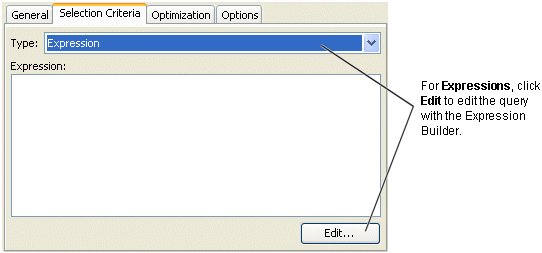
Use the following information to complete each field on this tab:
| Field | Description |
|---|---|
| Type | Specify if query uses a TopLink Expression, SQL, or EJB QL. |
| Expression or Query String | If the Type is SQL or EJB QL, enter the query string (either SQL or EJB QL).
TopLink Workbench does not validate the query string. See a note that follows this table for information on query syntax. |
Note:
Use a combination of an escape character and a double-quote ( \" ) instead of just a double-quote ( " ) when defining your query using SQL or EJB QL. For example:SELECT OBJECT(employee) FROM Employee employee WHERE employee.name = \"Bob\"
If you fail to do so, the generated Java code would look as follows:
query.setEJBQLString("SELECT OBJECT(employee) FROM Employee employee WHERE employee.name = "Bob"");
The preceding code produces an error at compile time.
If you define your query using the correct syntax, the generated Java code will contain no errors and be similar to the following:
query.setEJBQLString("SELECT OBJECT(employee) FROM Employee employee WHERE employee.name = \"Bob\"");
Use this tab to specify how the results of a read all query should be ordered by attribute name.
Select one of the following actions:
To add a new attribute by which to order query results, click Add. The Add Ordering Attribute dialog box appears. Select the mapped attribute to order by, specify ascending or descending order, and then click OK.
To change the order of the order attributes, select an existing attribute and click Up or Down.
To modify an existing order attribute's ordering options, select an existing attribute and click Edit.
To remove an order attribute, select an existing attribute and click Remove.
You can optimize a named query by configuring batch (ReadAllQuery only) or joining (ReadAllQuery and ReadObjectyQuery) attributes.
For more information on using batch reading, see Optimizing Queries, Section 12.12.9.2, "Reading Case 2: Batch Reading Objects", and Section 109.2.1.9, "Using Batch Reading".
For more information on joining, see Section 108.7.1.5, "Join Reading and Object-Level Read Queries" and Section 109.2.1.10, "Using Join Reading with ObjectLevelReadQuery".
Use this tab to specify batch reading and joining attributes.
Figure 119-11 Named Queries, Optimization Tab
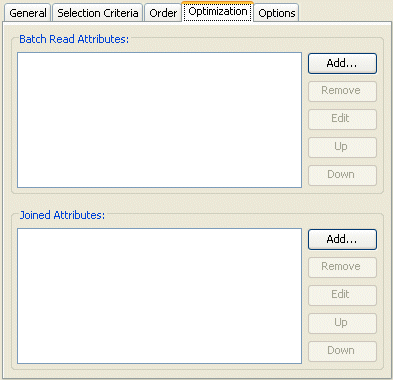
Select one of the following actions for Batch Read Attributes (ReadAllQuery only):
To add a new batch read attribute, click Add. The Add Batch Read Attribute dialog box appears. Select the mapped attribute and click OK.
To change the order of the batch read attributes, select an existing attribute and click Up or Down.
To modify an existing batch read attribute's options, select an existing attribute and click Edit.
To remove a batch read attribute, select an existing attribute and click Remove.
Select one of the following actions for Joined Attributes (ReadAllQuery and ReadObjectQuery):
To add a new joined attribute, click Add. The Add Joined Attribute dialog box appears.
Figure 119-12 Add Joined Attribute Dialog Box
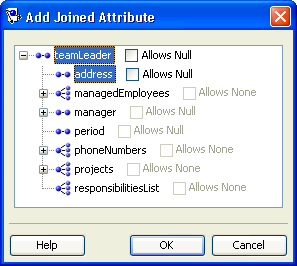
Select the mapped attribute. Optionally, enable or disable Allows Null or, for a Collection attribute, Allows None. Click OK.
To change the order of the joined attributes, select an existing attribute and click Up or Down.
To modify an existing joined attribute's options, select an existing attribute and click Edit.
To remove a joined attribute, select an existing attribute and click Remove.
For ReportQuery queries only, you can configure report query functions to apply to one or more attributes.
For more information about report queries, see Section 108.7.5, "Report Query".
Use this tab to configure report query attributes.
Figure 119-13 Named Queries, Attributes Tab
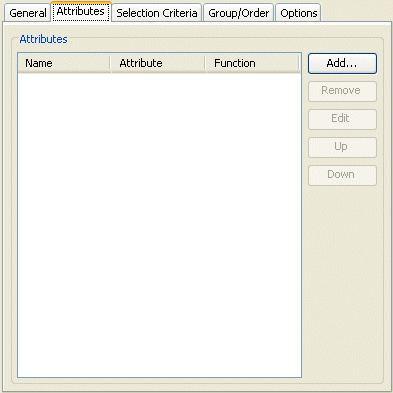
Select one of the following actions for Attributes (ReportQuery only):
To add a new report query attribute, click Add. The Add Joined Attribute dialog box appears. Continue with Section 119.7.1.6.1, "Adding Report Query Attributes".
To change the order of the report query attribute attributes, select an existing attribute and click Up or Down.
To modify an existing report query attribute's options, select an existing attribute and click Edit.
To remove a report query attribute, select an existing attribute and click Remove.
Note:
You can only choose attributes that are configured with a direct mapping (converters included) or a user-defined query key.Use this dialog box to add a report query attribute.
Figure 119-14 Add Report Query Attribute Dialog Box
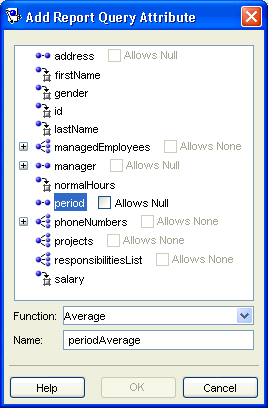
Select the attribute you want in this report query and use the following table to complete the dialog box and add the report query attribute:
| Option | 'Description |
|---|---|
| Allows None or Allows Null | Use the Allows Null and Allows None options to define an expression with an outer join.
Check the Allows Null option to use the Check the Allows None option for For more information, see Section 110.2.7.2, "Using TopLink Expression API for Joins". |
| Function | Select from the list of report query functions that TopLink provides. This function will be applied to the specified attribute. You must select an attribute for all functions, except Count.
Alternatively, you can enter the name of a custom function that you implement in your database. For more information, see |
| Name | The name associated with the calculated value. By default, the name is <AttributeName><FunctionName>. |
Enter the necessary information and click OK. TopLink Workbench adds the report query attribute to the list of attributes in the Attribute tab.
For ReportQuery queries only, you can configure grouping and ordering attributes.
For more information about report queries, see Section 108.7.5, "Report Query".
Use this tab to specify grouping and ordering attributes.
Figure 119-15 Named Queries, Group/Order Tab
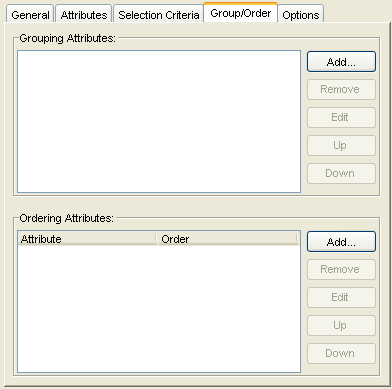
Select one of the following actions for Grouping Attributes (ReportQuery only):
To add a new grouping attribute, click Add. The Add Grouping Attribute dialog appears. Select the desired mapped attribute and click OK.
To change the order of the grouping attributes, select an existing attribute and click Up or Down.
To modify an existing grouping attribute's options, select an existing attribute and click Edit.
To remove a grouping attribute, select an existing attribute and click Remove.
Select one of the four following actions for Ordering Attributes (ReportQuery only):
To add a new ordering attribute, click Add. The Add Ordering Attribute dialog box appears. Continue with Section 119.7.1.7.1, "Adding Ordering Attributes".
To change the order of the ordering attributes, select an existing attribute and click Up or Down.
To modify an existing ordering attribute's options, select an existing attribute and click Edit.
To remove an ordering attribute, select an existing attribute and click Remove.
Use this dialog box to add a report query ordering attribute.
Figure 119-16 Add Ordering Attribute Dialog Box
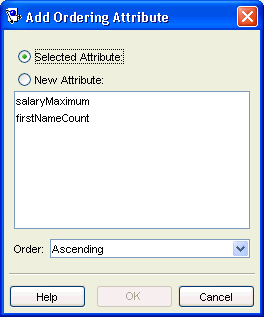
Use the following information to complete the fields on the dialog box and add an ordering attribute:
| Option | 'Description |
|---|---|
| Selected Attribute | Select this option to view a list of the report query attributes you added (see Section 119.7.1.6, "Configuring Named Query Attributes").
Select an attribute and choose its ordering option in the Order field. |
| New Attribute | Select this option to view a list of all class attributes.
Select an attribute and choose its ordering option in the Order field. |
| Order | Select ascending or descending. |
Enter the necessary information and click OK. TopLink Workbench adds the report query attribute to the list of attributes in the Attribute tab.
For an EIS root descriptor, you can define EIS interactions to invoke methods on an EIS.
You can use TopLink to define an interaction as a named query for read object and read all object queries, as described here. These queries are not called for basic persistence operations (Section 76.5, "Configuring Custom EIS Interactions for Basic Persistence Operations"); you can call these additional queries by name in your application for special purposes.
Use this tab to define an interaction as a named query for read object and read all object queries.
Use the following information to complete each field on the tab:
| Field | Description |
|---|---|
| Interaction Type | Using TopLink Workbench, you can only use XML Interactions. You cannot change this field. |
| Function Name | Specify the name of the EIS function that this call type (Read Object or Read All) invokes on the EIS. |
| Input Record Name | Specify the name passed to the JCA adapter when creating the input record. |
| Input Root Element | Specify the root element name to use for the input DOM. |
| Input Arguments | Specify the query argument name to map to the interaction field or XPath nodes in the argument record.
For example, if you are using XML records, use this option to map input argument |
| Output Arguments | Specify the result record field or XPath nodes to map the correct nodes in the record used by the descriptor's mappings.
For example, if you are using XML records, use this option to map the output Output arguments are not required if the interaction returns an XML result that matches the descriptor's mappings. |
| Input Result Path | Use this option if the EIS interaction expects the interaction arguments to be nested in the XML record.
For example, specify |
| Output Result Path | Use this option if the EIS interaction result record contains the XML data that maps to the objects in a nested structure.
For example, specify |
| Properties | Specify any properties required by your EIS platform. For example, property name operation (from AQPlatform.QUEUE_OPERATION) and property value enqueue (from AQPlatform.ENQUEUE). |
Use this tab to configure additional options for the query.
Use the following information to complete each field on the tab:
| Field | Description |
|---|---|
| Refresh Identity Map ResultsFootref 2 | Refreshes the attributes of the object(s) resulting from the query. If cascading is used, the private parts of the objects will also be refreshed. |
| Cache StatementFoot 1 | Caches the prepared statements. This requires full parameter binding as well (see Bind Parameters). |
| Bind ParametersFootref 1 | By default, TopLink binds all of the query's parameters.
Deselect this option to disable binding. |
| Cache UsageFoot 2 | Selects how TopLink should use the session cache when a query is executed:
For more information, see the following: |
| In Memory Query IndirectionFootref 2 | Selects how TopLink should handle indirection (lazy loading) when an in-memory or conforming query is executed:
For more information, see the following: |
| Return ChoiceFoot 3 | Selects how TopLink should handle ReportQuery results:
For more information, see Section 108.5.1, "Collection Query Results". |
| Retrieve Primary KeysFootref 3 | Selects whether or not TopLink retrieves the primary key values within each result. You can use the primary keys to retrieve the real objects.
|
Footnote 1 For more information, see Section 12.11.5, "How to Use Parameterized SQL (Parameter Binding) and Prepared Statement Caching for Optimization".
Footnote 2 For ReadObjectQuery and ReadAllQuery queries only.
Footnote 3 For ReportQuery queries only.
Click Advanced to configure additional options. See Section 119.7.1.10, "Configuring Named Query Advanced Options".
See Also
To configure additional advanced query options, use this procedure.
From the Named Queries – Options tab, click Advanced. The Advanced Query Options dialog box appears.
From the Named Queries – Options tab, click Advanced. The Advanced Query Options dialog box appears.
Figure 119-19 Advanced Query Options Dialog Box
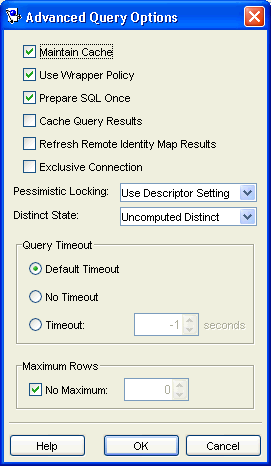
Complete each field in the Advanced Query Options dialog box.
Use the following information to enter data in each field and click OK:
| Field | Description |
|---|---|
| Maintain Cache | Specify whether to use the cache for the query or to build objects directly from the database result. You should only use this option if you are executing a partial object query (see Section 108.7.1.3, "Partial Object Queries"), whose results cannot be cached.
For more information, see Section 108.16.4, "How to Disable the Identity Map Cache Update During a Read Query". |
| Use Wrapper Policy | Specify whether or not the named query will use the wrapper policy configured for this descriptor.
For more information, see Section 119.32, "Configuring Wrapper Policy". |
| Prepare SQL Once | Specify the setShouldPrepare() for the named query. By default, TopLink optimizes queries to generate their SQL only once. You may need to disable this option for certain types of queries that require dynamic SQL based on their arguments, such as the following:
|
| Cache Query Results | Specify the cacheQueryResults method for the query. The query will only access the database the first time it is executed. Subsequent execution will return exactly the original result.
For more information, see Section 111.13.1, "How to Cache Results in a ReadQuery". |
| Refresh Remote Identity Map Results | Specify the refreshRemoteIdentityMapResult method for the query. TopLink can refresh the attributes of the object(s) resulting from the query. With cascading, TopLink will also refresh the private parts of the object(s). |
| Exclusive Connection | Specify whether or not the named query will use an exclusive connection. You can also configure exclusive connection acquisition at the session level (see Section 89.12, "Configuring Connection Policy". |
| Pessimistic Locking | Specify the specific pessimistic locking policy for the query or use the locking policy from the descriptor. |
| Distinct State | Specify if TopLink prints the DISTINCT clause, if a distinct has been set. The DISTINCT clause allows you to remove duplicates from the result set. |
| Query Timeout | Specify if the query will time out (or abort) after a specified number of seconds. |
| Maximum Rows | Specify if the query will limit the results to a specified number of rows. Use this to option for queries that could return an excessive number of objects. |
To configure named queries in Java, use a descriptor amendment method (see Section 119.35, "Configuring Amendment Methods"). Example 119-1 illustrates an amendment method that creates a named query and adds it to the DescriptorQueryManager.
Example 119-1 Creating a Named Query with an Amendment Method
public class EmployeeAmmendmentMethodClass {
....
// Create named query with Employee as its reference class
public static void createEmployeeQuery(ClassDescriptor descriptor) {
ReadObjectQuery query = new ReadObjectQuery(Employee.class);
ExpressionBuilder emp = query.getExpressionBuilder();
Expression firstNameExpression = emp.get("firstName").equal(emp.getParameter("firstName"));
query.setSelectionCriteria(firstNameExpression);
query.addArgument("firstName");
descriptor.getQueryManager().addQuery(
"employeeReadByFirstName", query);
}
}
You can specify how the TopLink runtime handles the duration of queries on a descriptor's reference class. Specifying a query timeout at the descriptor level applies to all queries on the descriptor's reference class. A query timeout ensures that your application does not block forever over a hung or lengthy query that does not return in a timely fashion.
Table 119-4 summarizes which descriptors support query timeout configuration.
Table 119-9 Descriptor Support for Cache Refresh
| Descriptor | How to Use Oracle JDeveloper | How to Configure Query Timeout at the Descriptor Level TopLink Workbench |
How to Configure Query Timeout at the Descriptor Level Java |
|---|---|---|---|
|
Relational DescriptorsFoot 1 |
|
|
|
|
Object-Relational Data Type Descriptors |
|
|
|
|
EIS Descriptor |
|
|
|
|
XML Descriptors |
|
|
|
Footnote 1 Relational class descriptors only (see Section 22.2.1.1, "Creating Relational Class Descriptors").
You can also configure a timeout on a per-query basis. For more information, see the following:
Section 119.7.1.10, "Configuring Named Query Advanced Options"
Section 109.2.1.8, "Configuring Query Timeout at the Query Level"
To configure how TopLink handles the duration of queries to this descriptor, use this procedure:
Select a descriptor in the Navigator. Its properties appear in the Editor.
Click the Settings tab. The Settings tab appears.
Figure 119-20 Descriptor Queries Settings Tab, Query Timeout Options
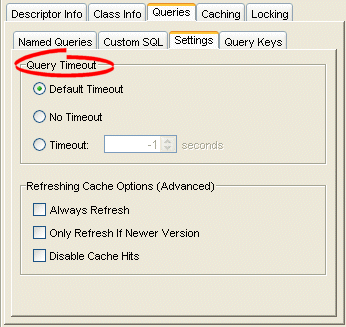
Use the following table to enter data in the fields on the descriptor's Settings tab to specify how TopLink handles query duration:
| Field | Description |
|---|---|
| Default Timeout | TopLink throws a DatabaseException if a query on this descriptor does not return within the timeout period you configure on the parent descriptor. If there is no parent descriptor, the query timeout defaults to No Timeout. |
| No Timeout | TopLink blocks until a query on this descriptor returns. |
| Timeout | Enter the timeout period in seconds. TopLink throws a DatabaseException if a query on this descriptor does not return within this time. |
Use DescriptorQueryManager method setQueryTimeout passing in the timeout value as a number of milliseconds.
By default, TopLink caches objects read from a data source (see Chapter 102, "Introduction to Cache"). Subsequent queries for these objects will access the cache and thus improve performance by reducing data source access and avoiding the cost of rebuilding object's and their relationships. Even if a query, such as a read-all query, accesses the data source, if the objects corresponding to the records returned are in the cache, TopLink will use the cache objects.
This can lead to stale data in the application. Although using an appropriate locking policy (see Section 119.26, "Configuring Locking Policy") is the only way to ensure that stale or conflicting data does not get committed to the data source, sometimes certain data in the application changes so frequently that it is desirable to always refresh the data, instead of only refreshing the data when a conflict is detected.
You can specify how the TopLink runtime handles cache refreshing for all queries on a descriptor's reference class.
Table 119-4 summarizes which descriptors support query cache refresh configuration.
Table 119-10 Descriptor Support for Query Cache Refresh
| Descriptor | How to Use Oracle JDeveloper | How to Configure Cache Refreshing Using TopLink Workbench |
How to Configure Cache Refreshing Using Java |
|---|---|---|---|
|
Relational DescriptorsFoot 1 |
|
|
|
|
Object-Relational Data Type Descriptors |
|
|
|
|
EIS DescriptorFoot 2 |
|
|
|
|
XML Descriptors |
|
|
|
Footnote 1 Relational class descriptors only (see Section 22.2.1.1, "Creating Relational Class Descriptors").
Footnote 2 EIS root descriptors only (see Section 75.2.1.1, "EIS Root Descriptors").
Configuring descriptor-level cache refresh may affect performance. As an alternative, consider configuring the following:
cache refresh on a query-by-query basis (see Section 108.16.5, "How to Refresh the Cache")
cache expiration (see Section 119.16, "Configuring Cache Expiration at the Descriptor Level")
isolated caching (see Section 102.2.7, "Cache Isolation")
For more information, see Section 12.10, "Optimizing Cache".
To configure how TopLink refreshes the cache for queries to this descriptor, use this procedure:
Select a descriptor in the Navigator. Its properties appear in the Editor.
Click the Settings tab. The Settings tab appears.
Figure 119-21 Descriptor Queries Settings Tab, Cache Refreshing Options
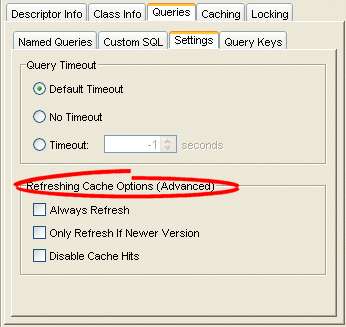
Use the following table to enter data in the fields on the descriptor's Settings tab to specify how TopLink will refresh the cache for queries:
| Field | Description |
|---|---|
| Always Refresh | Refreshes the cache on all queries.
Avoids stale data by ensuring that any query that accesses the data source will refresh the resulting objects in the cache. This has no effect on queries that get a cache hit and never access the data source, such as read-object primary key queries or in-memory queries. Configuring descriptor level cache refresh may affect performance. As an alternative, consider configuring:
|
| Only Refresh If Newer Version | Refreshes the cache only if the object in the database is newer than the object in the cache (as determined by the Optimistic Locking field). See Section 119.26, "Configuring Locking Policy" for more information.
Improves performance by avoiding unnecessary refreshing of an object if its version matches the data source version. This option does not cause refreshing on its own: you must use it in combination with Always Refresh, query refreshing (see Section 108.16.5, "How to Refresh the Cache"), or cache expiration (see Section 119.16, "Configuring Cache Expiration at the Descriptor Level"). |
| Disable Cache Hits | When selected, TopLink bypasses the cache and goes to the database for read object queries based on primary key. Using this option in conjunction with Always Refresh ensures that TopLink always goes to the database.
This option ensures that all queries including read-object primary key queries will always access the data source. This option does not cause refreshing on its own: you must use it in combination with Always Refresh. This option can cause a serious performance issue: avoid whenever possible. |
Caution:
Use the Always Refresh and Disable Cache Hits properties with caution as they may lead to poor performance. As an alternative, consider configuring cache refresh on a query-by-query basis (see Section 108.16.5, "How to Refresh the Cache") or configuring cache expiration (see Section 119.16, "Configuring Cache Expiration at the Descriptor Level"). For more information about cache performance, see Section 12.10, "Optimizing Cache".Configure cache refresh options using the following ClassDescriptor methods:
setShouldAlwaysRefreshCache
setShouldAlwaysRefreshCacheOnRemote
setShouldDisableCacheHits
setShouldDisableCacheHitsOnRemote
setShouldOnlyRefreshCacheIfNewerVersion
Use these methods in a descriptor amendment method (see Section 119.35, "Configuring Amendment Methods"), as Example 119-2 illustrates.
A query key is a schema-independent alias for a database field name. For example, consider a class Employee with attribute firstName mapped directly to a database field F_NAME in database table EMPLOYEE. Without a query key, when you create a query or expression that involves Employee attribute firstName, you must use the database management system-specific field name F_NAME. This makes it more difficult to build a query and ties the query to the schema. With a query key, you can refer to this field using a schema-independent alias, such as firstName.
Table 119-11 summarizes which descriptors support query keys.
Table 119-11 Descriptor Support for Query Keys
| Descriptor | How to Use Oracle JDeveloper | How to Configure Query Keys Using TopLink Workbench |
How to Configure Query Keys Using Java |
|---|---|---|---|
|
Relational Descriptors |
|
|
|
|
Object-Relational Data Type Descriptors |
|
||
|
EIS Descriptors |
|||
|
XML Descriptors |
Using query keys offers the following advantages:
Enhances code readability in TopLink expressions and simplifies expression development. You can compose expressions entirely within the context of your object model.
Increases portability by making code independent of the database schema. If you rename a field in your schema, you can redefine the query key without changing any code that uses it.
Query keys used with interface descriptors allow the implementor descriptor's tables to have different field names.
Query keys are automatically generated for all mapped attributes. The name of the query key is the name of the class attribute specified in your object model.
For information on how to use query keys in queries and expressions, see Section 108.2.7, "Query Keys".
When query keys are generated and how you can add or modify query keys depends on the type of mapping or descriptor involved:
Direct Mappings
TopLink Workbench automatically generates query keys for all direct mappings at the time you create the mapping.
TopLink Workbench provides support for adding or modifying query keys for simple unmapped attributes that could be mapped by a direct mapping: for example, the version field used for optimistic locking or the type field used for inheritance. You cannot modify or remove automatically generated query keys.
Relationship Mappings
TopLink automatically generates query keys for all relationship mappings at run time.
For example, if you have a class Customer with attribute orders mapped in a one-to-many relationship to class PurchaseOrders, then the TopLink runtime will generate a query key named orders for this Customer attribute.
Neither Oracle JDeveloper nor TopLink Workbench currently support adding or modifying the query keys for relationship mappings. If you must add or modify such a query key, you must do so in Java code, using a descriptor amendment method.
Interface Descriptors
Interface descriptors (see Section 22.2.1.3, "Creating Relational Interface Descriptors") define only the query keys that are shared among their implementors. In the descriptor for an interface, only the name of the query key is specified.
TopLink Workbench provides support for choosing the implementors of an interface that share at least one common automatically generated query key (see Section 119.11, "Configuring Interface Query Keys").
To add query keys to simple unmapped fields and to view the query keys automatically generated for directly mapped attributes, use this procedure:
Select a descriptor in the Navigator. Its properties appear in the Editor.
To add a new query key, click Add.
To delete an existing query key, select the query key and click Remove.
To rename an existing query key, select the query key and click Rename.
Use the Field list to select the field in the table associated with the query key.
To manually create a relationship query key, implement a descriptor amendment method (see Section 119.35, "Configuring Amendment Methods") that uses one of the following ClassDescriptor methods to register the query keys:
addQueryKey–specify a query key using an instance of QueryKey such as DirectQueryKey, DirectCollectionQueryKey, ManyToManyQueryKey, OneToManyQueryKey, or OneToOneQueryKey.
addDirectQueryKey–add a query key that maps directly to the given database field.
addAbstractQueryKey–add an abstract query key to an interface descriptor. Any implementors of that interface must define the query key defined by this abstract query key.
Example 119-3, Example 119-4, and Example 119-5 illustrate how to define a query key in Java code.
Example 119-3 Defining a Query Key
// Add a query key for the foreign key field using the direct method descriptor.addDirectQueryKey("managerId", "MANAGER_ID"); // The same query key can also be added through the addQueryKey method DirectQueryKey directQueryKey = new DirectQueryKey(); directQueryKey.setName("managerId"); directQueryKey.setFieldName("MANAGER_ID"); descriptor.addQueryKey(directQueryKey); // Add a one-to-one query key for the large project of which the // employee is a leader (this assumes only one project) OneToOneQueryKey projectQueryKey = new OneToOneQueryKey(); projectQueryKey.setName("managedLargeProject"); projectQueryKey.setReferenceClass(LargeProject.class); ExpressionBuilder builder = new ExpressionBuilder(); projectQueryKey.setJoinCriteria(builder.getField( "PROJECT.LEADER_ID").equal(builder.getParameter("EMPLOYEE.EMP_ID"))); descriptor.addQueryKey(projectQueryKey);
Example 119-4 Defining a One-to-Many Query Key
// Add a one-to-many query key for the projects where the employee // manages multiple projects OneToManyQueryKey projectsQueryKey = new OneToManyQueryKey(); projectsQueryKey.setName("managedProjects"); projectsQueryKey.setReferenceClass(Project.class); ExpressionBuilder builder = new ExpressionBuilder(); projectsQueryKey.setJoinCriteria(builder.getField( "PROJECT.LEADER_ID").equal(builder.getParameter("EMPLOYEE.EMP_ID"))); descriptor.addQueryKey(projectsQueryKey);
Example 119-5 Defining a Many-to-Many Query Key
// Add a many-to-many query key to an employee project that uses a join table
ManyToManyQueryKey projectsQueryKey = new ManyToManyQueryKey();
projectsQueryKey.setName("projects");
projectsQueryKey.setReferenceClass(Project.class);
ExpressionBuilder builder = new ExpressionBuilder();
projectsQueryKey.setJoinCriteria(
builder.getTable("EMP_PROJ").getField("EMP_ID").equal(
builder.getParameter("EMPLOYEE.EMP_ID").and(
builder.getTable("EMP_PROJ").getField("PROJ_ID").equal(
builder.getField("PROJECT.PROJ_ID")));
descriptor.addQueryKey(projectsQueryKey);
Example 119-6 illustrates how to implement a Descriptor amendment method to define a one-to-one query key. In this example, the object model for the Address class does not include a reference to its owner, an Employee object. You can amend the Address class descriptor to add a query key named owner to make up for this deficiency. At run time, you can compose expressions that select Address objects based on this owner query key.
Example 119-6 Defining a One-to-One Query Key with an Amendment Method
// Static amendment method in Address class, addresses do not know // their owners in the object model, however you can still // query on their owner if a user-defined query key is defined public static void addToDescriptor(Descriptor descriptor) { OneToOneQueryKey ownerQueryKey = new OneToOneQueryKey(); ownerQueryKey.setName("owner"); ownerQueryKey.setReferenceClass(Employee.class); ExpressionBuilder builder = new ExpressionBuilder(); ownerQueryKey.setJoinCriteria( builder.getField("EMPLOYEE.ADDRESS_ID").equal( builder.getParameter("ADDRESS.ADDRESS_ID"))); descriptor.addQueryKey(ownerQueryKey); }
A query key is a schema independent alias for a database field name. For more information about query keys, see Section 119.10, "Configuring Query Keys".
Interface descriptors (see Section 22.2.1.3, "Creating Relational Interface Descriptors") are defined only with query keys that are shared among their implementors. In the descriptor for an interface, only the name of the query key is specified.
In each implementor descriptor, the key must be defined with the appropriate field from one of the implementor descriptor's tables.
This allows queries and relationship mappings to be defined on the interface using the query key names.
Interface query keys are supported in relational database projects only.
Table 119-11 summarizes which descriptors support interface query keys.
Table 119-12 Descriptor Support for Interface Query Keys
| Descriptor | How to Use Oracle JDeveloper | How to Configure Interface Query Keys Using TopLink Workbench |
How to Configure Interface Query Keys Using Java |
|---|---|---|---|
|
Relational Descriptors |
|
|
|
|
Object-Relational Data Type Descriptors |
|
||
|
EIS Descriptors |
|||
|
XML Descriptors |
Consider an Employee that contains a contact of type Contact. The Contact class is an interface with two implementors: Phone and Email. The Phone class has attributes id and number. The Email class has attributes id and address. Figure 119-23 illustrates the generated keys:
Figure 119-23 Automatically Generated Query Keys for Phone and Email

Both classes have an attribute, id, that is directly mapped to fields that have different names. However, a query key is generated for this attribute. For the Contact interface descriptor, you must indicate that the id query key must be defined for each of the implementors.
If either of the implementor classes did not have the id query key defined, Oracle JDeveloper and TopLink Workbench would flag that descriptor as deficient.
Now that a descriptor with a commonly shared query key has been defined for Contact, you can use it as the reference class for a variable one-to-one mapping (see Section 111.8, "Using Queries on Variable One-to-One Mappings").
For example, you can now create a variable one-to-one mapping for the contact attribute of Employee. When you edit the foreign key field information for the mapping, you must match the Employee descriptor's tables to query keys from the Contact interface descriptor.
To choose the implementors of an interface that share at least one common automatically generated query key, use this procedure.
Select an interface descriptor in the Navigator. Its properties appear in the Editor.
Figure 119-24 Interface Descriptor Editor Window
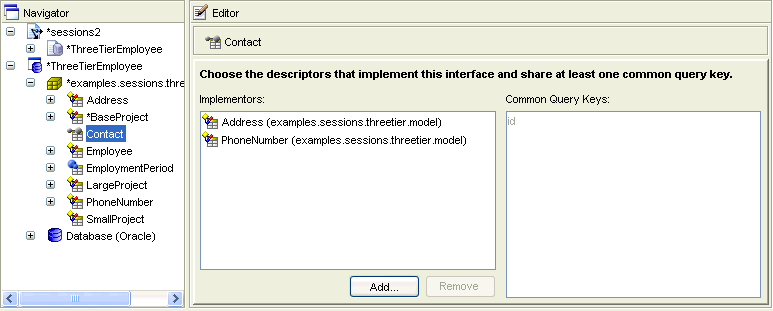
To choose an implementor of the selected interface that shares at least one common query key, click Add.
To remove an implementor of the selected interface, select the implementor and click Remove.
Example 119-7 shows how to define the Contact interface and Email and Phone implementors in Java.
Example 119-7 Defining Interface Query Keys
Descriptor contactInterfaceDescriptor = new Descriptor();
contactInterfaceDescriptor.setJavaInterface(Contact.class);
contactInterfaceDescriptor.addAbstractQueryKey("id");
Descriptor emailClassDescriptor = new Descriptor();
emailClassDescriptor.setJavaClass(Email.class);
emailClassDescriptor.addDirectQueryKey("id", "E_ID");
emailClassDescriptor.getInterfacePolicy().addParentInterface(Contact.class);
emailClassDescriptor.setTableName("INT_EML");
emailClassDescriptor.setPrimaryKeyFieldName("E_ID");
emailClassDescriptor.setSequenceNumberName("SEQ");
emailClassDescriptor.setSequenceNumberFieldName("E_ID");
emailClassDescriptor.addDirectMapping("emailID", "E_ID");
emailClassDescriptor.addDirectMapping("address", "ADDR");
Descriptor phoneClassDescriptor = new Descriptor();
phoneClassDescriptor.setJavaClass(Phone.class);
phoneClassDescriptor.getInterfacePolicy().addParentInterface(Contact.class);
phoneClassDescriptor.addDirectQueryKey("id", "P_ID");
phoneClassDescriptor.setTableName("INT_PHN");
phoneClassDescriptor.setPrimaryKeyFieldName("P_ID");
phoneClassDescriptor.setSequenceNumberName("SEQ");
phoneClassDescriptor.setSequenceNumberFieldName("P_ID");
phoneClassDescriptor.addDirectMapping("phoneID", "P_ID");
phoneClassDescriptor.addDirectMapping("number", "P_NUM");
The TopLink cache is an in-memory repository that stores recently read or written objects based on class and primary key values. TopLink uses the cache to do the following:
improve performance by holding recently read or written objects and accessing them in-memory to minimize database access;
manage locking and isolation level;
manage object identity.
Table 119-13 summarizes which descriptors support identity map configuration.
Table 119-13 Descriptor Support for Identity Map
| Descriptor | How to Use Oracle JDeveloper | How to Configure Cache Type and Size at the Descriptor Level Using TopLink Workbench |
How to Configure Cache Type and Size at the Descriptor Level Using Java |
|---|---|---|---|
|
Relational DescriptorsFoot 1 |
|
|
|
|
Object-Relational Data Type Descriptors |
|
||
|
EIS DescriptorsFoot 2 |
|
|
|
|
XML Descriptors |
Footnote 1 Relational class descriptors only (see Section 22.2.1.1, "Creating Relational Class Descriptors").
Footnote 2 EIS root descriptors only (see Section 75.2.1.1, "EIS Root Descriptors").
This configuration overrides the default identity map configuration defined at the project level (see Section 117.10, "Configuring Cache Type and Size at the Project Level").
For detailed information on caching and object identity, and the recommended settings to maximize TopLink performance, see to Section 102.2.1, "Cache Type and Object Identity".
For more information about the cache, see Chapter 102, "Introduction to Cache".
To specify the identity map information for a descriptor, use this procedure:
Select the descriptor in the Navigator.
Select the Caching tab in the Editor. The Caching tab appears.
Figure 119-25 Caching Tab, Identity Map Options
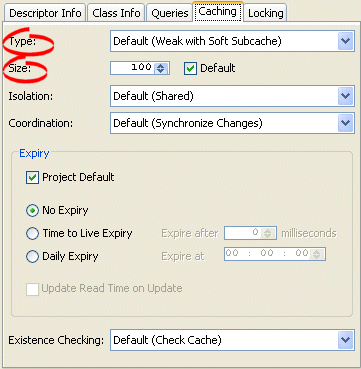
Use the following table to enter data in following fields on the Caching tab:
| Field | Description |
|---|---|
| TypeFoot 1 | Use the Type list to choose the identity map as follows:
For more information, see Section 102.2.1, "Cache Type and Object Identity". Changing the project's default identity map does not affect descriptors that already exist in the project. |
| SizeFootref 1 | Specify the size of the cache as follows:
|
| Default | When you enter a cache size, the Default check box is cleared. To reset the size to the default for the selected cache type, check the Default check box. |
Footnote 1 If a descriptor is a child in an inheritance hierarchy, TopLink makes this field read only and displays the options from the parent root descriptor. For more information, see Section 16.2.3.3, "Inheritance".
Use one of the following ClassDescriptor methods to configure the descriptor to use the appropriate type of identity map:
useFullIdentitMap
useWeakIdentityMap
useSoftIdentityMap
useSoftCacheWeakIdentityMap
useHardCacheWeakIdentityMap
useNoIdentityMap
Use the ClassDescriptor method setIdentityMapSize to configure the size of the identity map.
If you plan to use isolated sessions (see Section 102.2.7, "Cache Isolation"), you must configure descriptors as isolated for any object that you want confined to an isolated session cache.
Configuring a descriptor to be isolated means that TopLink will not store the object in the shared session cache and the object will not be shared across client sessions. Each client will have their own object read directly from the database. Objects in an isolated client session cache can reference objects in their parent server session's shared session cache, but no objects in the shared session cache can reference objects in an isolated client session cache. Isolation is required when using Oracle Database Virtual Private Database (VPD) support or database user-based read security. Isolation can also be used if caching is not desired across client sessions.
Table 119-13 summarizes which descriptors support cache isolation configuration.
Table 119-14 Descriptor Support for Cache Isolation Map
| Descriptor | How to Use Oracle JDeveloper | How to Configure Cache Isolation at the Descriptor Level Using TopLink Workbench |
How to Configure Cache Isolation at the Descriptor Level Using Java |
|---|---|---|---|
|
Relational DescriptorsFoot 1 |
|
|
|
|
Object-Relational Data Type Descriptors |
|
||
|
EIS DescriptorsFoot 2 |
|
|
|
|
XML Descriptors |
Footnote 1 Relational class descriptors only (see Section 22.2.1.1, "Creating Relational Class Descriptors").
Footnote 2 EIS root descriptors only (see Section 75.2.1.1, "EIS Root Descriptors").
This configuration overrides the default cache isolation configuration defined at the project level (see Section 117.11, "Configuring Cache Isolation at the Project Level").
Note:
If you configure a descriptor as isolated, it cannot participate in a coordinated cache (see Section 119.15, "Configuring Cache Coordination Change Propagation at the Descriptor Level").To specify the cache isolation options, use this procedure:
Select the descriptor in the Navigator.
Select the Caching tab in the Editor. The Caching tab appears.
Figure 119-26 Caching Tab, Isolation Options
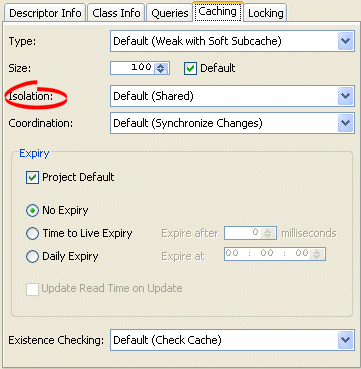
Use the Isolation list to choose one of the following:
Isolated–if you want all objects confined to an isolated client session cache. For more information, see Section 102.2.7, "Cache Isolation".
Shared–if you want all objects visible in the shared session cache (default).
To specify that a class is isolated, use a descriptor amendment method (see Section 119.35, "Configuring Amendment Methods") to call ClassDescriptor method setIsIsolated, passing in a boolean of true.
Use this policy to determine how a unit of work uses a session cache for a specific class. Table 119-15 lists the unit of work cache isolation options.
Table 119-15 Unit of Work Cache Isolation Options
| Option | Description |
|---|---|
|
Using the Session Cache After the Transaction |
This options is the most efficient as it allows the cache to be used after an early transaction. |
|
Isolating New Data After the Transaction |
This still allows previously cached objects to be accessed in the unit of work after an early transaction, while ensuring that uncommitted data will never be put in the session cache by storing any object built from new data only in the unit of work |
|
Isolating the Cache after the Transaction |
Note: This option may affect performance because you are bypassing the session cache after an early transaction. |
|
Always Isolating the Cache |
Note: This option my affect performance because you are bypassing the session cache. However if this class is isolated or pessimistic locked and always accessed in a transaction, this can avoid having to build two copies of the object. |
Most of these options apply only to a unit of work in an early transaction, such as the following:
A unit of work that was flushed (write changes).
Issued a modify query.
Acquired a pessimistic lock.
To specify that a class is isolated, use a descriptor amendment method (see Section 119.35, "Configuring Amendment Methods") to call ClassDescriptor method setUnitOfWorkCacheIsolationLevel.
If you plan to use a coordinated cache (see Section 102.3, "Cache Coordination"), you can configure how, and under what conditions, a coordinated cache propagates changes for a given descriptor.
Table 119-13 summarizes which descriptors support cache isolation configuration.
Table 119-16 Descriptor Support for Cache Coordination Change Propagation Configuration
| Descriptor | How to Use Oracle JDeveloper | How to Configure Cache Coordination Change Propagation at the Descriptor Level Using TopLink Workbench |
How to Configure Cache Coordination Change Propagation at the Descriptor Level Using Java |
|---|---|---|---|
|
Relational DescriptorsFoot 1 |
|
|
|
|
Object-Relational Data Type Descriptors |
|
||
|
EIS DescriptorsFoot 2 |
|
|
|
|
XML Descriptors |
Footnote 1 Relational class descriptors only (see Section 22.2.1.1, "Creating Relational Class Descriptors").
Footnote 2 EIS root descriptors only (see Section 75.2.1.1, "EIS Root Descriptors").
This configuration overrides the default cache coordination change propagation configuration defined at the project level (see Section 117.12, "Configuring Cache Coordination Change Propagation at the Project Level").
To complete your coordinated cache configuration, see Chapter 103, "Configuring a Coordinated Cache".
Note:
If you configure a descriptor as isolated (see Section 119.13, "Configuring Cache Isolation at the Descriptor Level"), it cannot participate in a coordinated cache.To specify the coordinated cache change propagation options, use this procedure:
Select the descriptor in the Navigator.
Select the Caching tab in the Editor. The Caching tab appears.
Figure 119-27 Caching Tab, Coordination Options
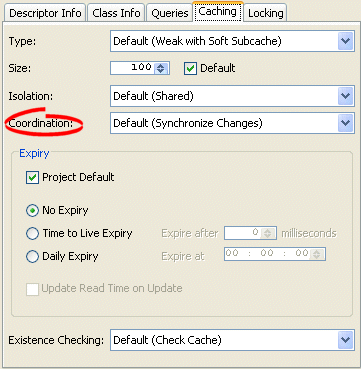
Use the following information to enter data in the Coordination field:
| Coordination Option | Description | When to Use |
|---|---|---|
| None | For both existing and new instances, do not propagate a change notification. | Infrequently read or changed objects. |
| Synchronize Changes | For an existing instance, propagate a change notification that contains each changed attribute.
For a new instance, propagate an object creation (along with all the new instance's attributes) only if the new instance is related to other existing objects that are also configured with this change propagation option. |
Frequently read or changed objects that contain few attributes or in cases where only a few attributes are frequently changed.
Objects that have many or complex relationships. |
| Synchronize Changes and New Objects | For an existing instance, propagate a change notification that contains each changed attribute.
For a new instance, propagate an object creation (along with all the new instance's attributes). |
Frequently read or changed objects that contain few attributes or in cases where only a few attributes are frequently changed.
Objects that have few or simple relationships. |
| Invalidate Changed Objects | For an existing instance, propagate an object invalidation that marks the object as invalid in all other sessions. This tells other sessions that they must update their cache from the data source the next time this object is read.
For a new instance, no change notification is propagated. |
Frequently read or changed objects that contain many attributes in cases where many of the attributes are frequently changed. |
Use a descriptor amendment method (see Section 119.35, "Configuring Amendment Methods") to invoke ClassDescriptor method setCacheSynchronizationType passing in one of the following parameters:
ClassDescriptor.DO_NOT_SEND_CHANGES
ClassDescriptor.SEND_OBJECT_CHANGES
ClassDescriptor.SEND_NEW_OBJECTS_WITH_CHANGES
ClassDescriptor.INVALIDATE_CHANGED_OBJECTS
By default, objects remain in the cache until they are explicitly deleted (see Section 114.7, "Deleting Objects") or garbage-collected when using a weak identity map (see Section 117.11, "Configuring Cache Isolation at the Project Level"). Alternatively, you can configure an object with a CacheInvalidationPolicy that allows you to specify, either automatically or manually, that an object is invalid: when any query attempts to read an invalid object, TopLink will go to the data source for the most up-to-date version of that object and update the cache with this information.
Using cache invalidation ensures that your application does not use stale data. It provides a better performing alternative to always refreshing (see Section 119.9, "Configuring Cache Refreshing").
Table 119-17 summarizes which descriptors support a cache invalidation policy.
Table 119-17 Descriptor Support for Cache Invalidation Policy
| Descriptor | How to Use Oracle JDeveloper | How to Configure Cache Expiration at the Descriptor Level Using TopLink Workbench |
How to Configure Cache Expiration at the Descriptor Level Using Java |
|---|---|---|---|
|
Relational DescriptorsFoot 1 |
|
|
|
|
Object-Relational Data Type Descriptors |
|
||
|
EIS DescriptorsFoot 2 |
|
|
|
|
XML Descriptors |
Footnote 1 Relational class descriptors only (see Section 22.2.1.1, "Creating Relational Class Descriptors").
Footnote 2 EIS root descriptors only (see Section 75.2.1.1, "EIS Root Descriptors").
You can override the project-level cache invalidation configuration (see Section 117.13, "Configuring Cache Expiration at the Project Level") by defining cache invalidation at the descriptor or query level (see Section 111.13.2, "How to Configure Cache Expiration at the Query Level").
You can customize how TopLink communicates the fact that an object has been declared invalid to improve efficiency, if you are using a coordinated cache. For more information, see Section 119.15, "Configuring Cache Coordination Change Propagation at the Descriptor Level".
For more information, see Section 102.2.5, "Cache Invalidation".
To specify the cache invalidation information for a descriptor, use this procedure:
Select the descriptor in the Navigator.
Select the Caching tab in the Editor. The Caching tab appears.
Figure 119-28 Caching Tab, Expiration Options
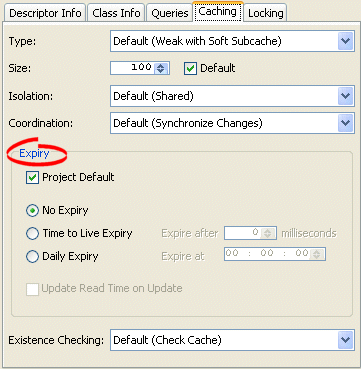
Use this table to enter data in the following fields on the Caching tab to specify the cache invalidation policy for the descriptors.
| Field | Description |
|---|---|
| Project Default | Use the project's cache expiration options for this descriptor. See Section 117.13, "Configuring Cache Expiration at the Project Level" for more information. |
| No Expiry | Specify that objects in the cache do not expire. |
| Time to Live Expiry | Specify that objects in the cache will expire after a specified amount of time. Use the Expire After field to indicate the time (in milliseconds) after which the objects will expire. |
| Daily Expiry | Specify that objects in the cache will expire at a specific time each day. Use the Expire At field to indicate the exact time to the second (using a 24-hour clock) at which the objects will expire. |
| Update Read Time on Update | Specify if TopLink should reset the cached object's expiry time after the TopLink successfully updates the object. |
Note:
These options apply per descriptor. See Section 117.13, "Configuring Cache Expiration at the Project Level" for information on configuring project-level options.Use ClassDescriptor method setCacheInvalidationPolicy to set an appropriate instance of CacheInvalidationPolicy.
When TopLink writes an object to the database, TopLink runs an existence check to determine whether to perform an insert or an update.
By default, TopLink checks against the cache. Oracle recommends that you use this default existence check option for most applications. Checking the database for existence can cause a performance bottleneck in your application.
Table 119-18 summarizes which descriptors support existence checking.
Table 119-18 Descriptor Support for Existence Checking
| Descriptor | How to Use Oracle JDeveloper | How to Configure Cache Existence Checking at the Descriptor Level Using TopLink Workbench |
How to Configure Cache Existence Checking at the Descriptor Level Using Java |
|---|---|---|---|
|
Relational DescriptorsFoot 1 |
|
|
|
|
Object-Relational Data Type Descriptors |
|
||
|
EIS DescriptorsFoot 2 |
|
|
|
|
XML Descriptors |
Footnote 1 Relational class descriptors only (see Section 22.2.1.1, "Creating Relational Class Descriptors").
Footnote 2 EIS root descriptors only (see Section 75.2.1.1, "EIS Root Descriptors").
You can configure existence checking at the descriptor level to override the project level configuration (see Section 117.7, "Configuring Existence Checking at the Project Level").
For more information see the following:
To specify the existence checking information for a descriptor, use this procedure:
Select the descriptor in the Navigator.
Select the Caching tab in the Editor. The Caching tab appears.
Figure 119-29 Caching Tab, Existence Checking Options
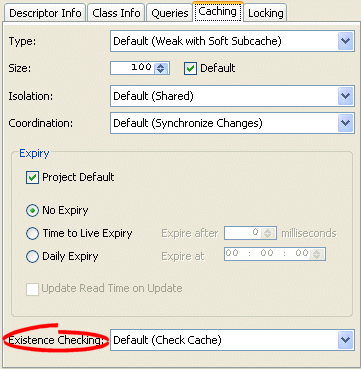
Use this table to enter data in the following fields of the tab to specify the existence checking options for newly created descriptors:
| Field | Description |
|---|---|
| Check Cache | Check the session cache. If the object is not in the cache, assume that the object does not exist (do an insert). If the object is in the cache, assume that the object exists (do an update). Oracle recommends using this option for most applications. |
| Check Cache then Database | If an object is not in the cache, query the database to determine if the object exists. If the object exists, do an update. Otherwise, do an insert. Selecting this option may negatively impact performance. For more information, see Section 115.1.3.1, "Using Check Database". |
| Assume Existence | Always assume objects exist: always do an update (never do an insert). For more information, see Section 115.1.3.2, "Using Assume Existence". |
| Assume Non-Existence | Always assume objects do not exist: always do an insert (never do an update). For more information, see Section 115.1.3.3, "Using Assume Nonexistence". |
To configure existence checking at the descriptor level using Java, use ClassDescriptor method getQueryManager to acquire the DescriptorQueryManager from the descriptor and then use one of the following DescriptorQueryManager methods (see Example 119-8):
checkCacheForDoesExist–check the session cache. If the object is not in the cache, assume that the object does not exist (do an insert). If the object is in the cache, assume that the object exists (do an update). Oracle recommends using this option for most applications.
checkDatabaseForDoesExist–if an object is not in the cache, query the database to determine if the object exists. If the object exists, do an update. Otherwise, do an insert. Selecting this option may negatively impact performance. For more information, see Section 115.1.3.1, "Using Check Database".
assumeExistenceForDoesExist–always assume objects exist: always do an update (never do an insert). For more information, see Section 115.1.3.2, "Using Assume Existence".
assumeNonExistenceForDoesExist–always assume objects do not exist: always do an insert (never do an update). For more information, see Section 115.1.3.3, "Using Assume Nonexistence".
If your project uses EJB CMP or BMP (see Section 117.5, "Configuring Persistence Type"), you can use descriptors to describe the characteristics of entity beans with container-managed or bean-managed persistence.
Table 119-19 summarizes which descriptors support EJB information.
Table 119-19 Descriptor Support for EJB Information
| Descriptor | How to Use Oracle JDeveloper | How to Configure a Descriptor with EJB CMP and BMP Information Using TopLink Workbench |
How to Configure a Descriptor with EJB CMP and BMP Information Using Java |
|---|---|---|---|
|
Relational DescriptorsFoot 1 |
|
|
|
|
Object-Relational Data Type Descriptors |
|
|
|
|
EIS DescriptorsFoot 2 |
|
|
|
|
XML Descriptors |
|
|
|
Footnote 1 Relational class descriptors only (see Section 22.2.1.1, "Creating Relational Class Descriptors").
Footnote 2 EIS root descriptors only (see Section 75.2.1.1, "EIS Root Descriptors").
When mapping enterprise beans, you create a descriptor for the bean class; you do not create a descriptor for the local interface, remote interface, home class, or primary key class.
When using TopLink Workbench, you must define the project with the correct entity bean type (such as container-managed or bean-managed persistence) and import the ejb-jar.xml file for the beans into the TopLink Workbench project.
For CMP projects, the ejb-jar.xml file defines the bean's attributes to be mapped. A descriptor for an entity bean container-managed persistence contains a CMP policy used to configure CMP-specific options.
For more information, see Section 16.2.3, "Descriptors and CMP and BMP".
To configure a descriptor with EJB information, use this procedure:
In the Navigator, select a relational descriptor.
![]()
Click EJB Descriptor on the mapping toolbar.
An EJB Info tab is added to the descriptor.
To remove the EJB information for the selected descriptor, click EJB Descriptor again.
The EJB Info tab is removed from the descriptor.
Use the following information to enter data in each field on the tab:
| Field | Description |
|---|---|
| EJB Name | Enter the bean's base name. This is specified in the <ejb-name> element of the ejb-jar.xml file and is for display only. |
| Primary Key Class | Enter the primary key. This is specified in the <prim-key-class> element of the ejb-jar.xml file and is for display only. |
| Unknown Primary Key Class | Check this option if you choose not to specify the primary key class or the primary key fields for an entity bean with container managed persistence.
For example, select this field if the entity bean does not have a natural primary key or you want the deployer to select the primary key fields at deployment time. For more information, see Section 8.9.2, "How to Configure EJB CMP Unknown Primary Key Class Support". |
| Local Interface | Enter the local interface. This is specified in the <local> element of the ejb-jar.xml file and is for display only. |
| Local Home Interface | Enter the local home interface. This is specified in the <local-home> element of the ejb-jar.xml file and is for display only. |
| Remote Interface | Enter the remote interface. This is specified in the <remote> element of the ejb-jar.xml file and is for display only. |
| Remote Home Interface | Enter the remote interface. This is specified in the <home> element of the ejb-jar.xml file and is for display only. |
| Change Deferral | Use these options to specify how TopLink updates the database for this EJB descriptor. |
| Defer All Changes | Specify not to send changes to the database until the JTA transaction is committed. This is the default TopLink behavior. This is the most efficient option that results in the least amount of data source interaction. |
| Defer Updates Only | Specify to send changes to the database immediately after any insert or delete operation, but do not send changes to the data source for update operations until the JTA transaction is committed.
Select this option for backwards compatibility with some EJB containers, such as OC4J. For more information, see Section 16.2.3.1, "Nondeferred Changes"). Use this option with caution as it will require the data source transaction and locks to be held longer and may cause referential integrity issues. |
| Defer None | Specify to send all changes to the database immediately. This is the least efficient option that generates the greatest amount of data source interaction.
Select this option for backwards compatibility with some EJB containers, such as OC4J. For more information, see Section 16.2.3.1, "Nondeferred Changes"). |
| Insert New Objects After | Specify to send new object insert changes to the database after bean life cycle method ejbCreate (default) or ejbPostCreate. This is only relevant when not deferring changes (see Section 119.30, "Configuring Change Policy").
If non-null foreign key constraints cannot be satisfied when the insert is performed after |
Using Java code, you can use descriptors to describe the characteristics of entity beans with container-managed (see Section 119.18.2.1, "Configuring CMP Information") or bean-managed (see Section 119.18.2.2, "Configuring BMP Information") persistence.
To configure CMP-specific information on a descriptor, define a CMPPolicy:
descriptor.setCMPPolicy(new CMPPolicy());
You can use the following CMPPolicy API to configure optional behavior of enterprise beans:
Note:
Most of these options are provided for compatibility with other CMP implementations. Use caution when using them as they will affect application performance.setDeferModificationsUntilCommit–By default TopLink defers all changes to the database until the transaction is committed. Use this method to configure TopLink to update the database after each EJB operation for the specified deferral level:
CMPPolicy.NONE–default behavior
CMPPolicy.UPDATE_MODIFICATIONS–update the database after each EJB operation for update modifications only
CMPPolicy.ALL_MODIFICATIONS–update the database after each EJB operation for all modifications
setNonDeferredCreateTime–when using nondeferred writes (see setDeferModificationsUntilCommit), use this method to configure TopLink to insert a new enterprise bean before (CMPPolicy.AFTER_EJBCREATE) or after (CMPPolicy.AFTER_EJBPOSTCREATE) the ejbPostCreate method.
setForceUpdate–use this method to make TopLink write all enterprise beans that have been accessed to the database regardless of whether they changed or not.
setUpdateAllFields–use this method to configure TopLink to force all the fields of the bean to be updated instead of only the changed fields.
setPessimisticLockingPolicy–use this method to configure EJB-level pessimistic locking.
BMP descriptors must be configured with a BMPWrapperPolicy. Neither Oracle JDeveloper nor TopLink Workbench currently support defining the BMPWrapperPolicy, so you must define this through Java code.
For more information, see Section 119.32, "Configuring Wrapper Policy".
If you are mapping an inheritance hierarchy, by default, queries on root or branch classes return instances of the root class and their subclasses.
Alternatively, you can configure a root or branch class descriptor to do the following:
not include subclasses when the root or branch class is queried;
outer-join subclasses when the root or branch class is queried.
You can also specify a database view to optimize the reading of subclasses. The view can be used to optimize queries for root or branch classes that have subclasses spanning multiple tables. The view must apply an outer-join or union all of the subclass tables.
Do not configure this option for leaf classes.
Table 119-20 summarizes which descriptors support inherited attribute mapping configuration.
Table 119-20 Descriptor Support for Inherited Attribute Mapping Configuration
| Descriptor | How to Use Oracle JDeveloper | How to Configure Reading Subclasses on Queries Using TopLink Workbench |
How to Configure Reading Subclasses on Queries Using Java |
|---|---|---|---|
|
Relational Descriptors |
|
|
|
|
Object-Relational Data Type Descriptors |
|
|
|
|
EIS Descriptors |
|||
|
XML Descriptors |
|
For more information, see Section 16.2.2, "Descriptors and Inheritance".
To configure reading classes on subqueries, use this procedure:
In the Navigator, select a root or branch descriptor.
If the Inheritance advanced property is not visible for the descriptor, right-click the descriptor and choose Select Advanced Properties > Inheritance from context menu or from the Selected menu.
Figure 119-31 Inheritance Tab, Read Subclasses on Query Option
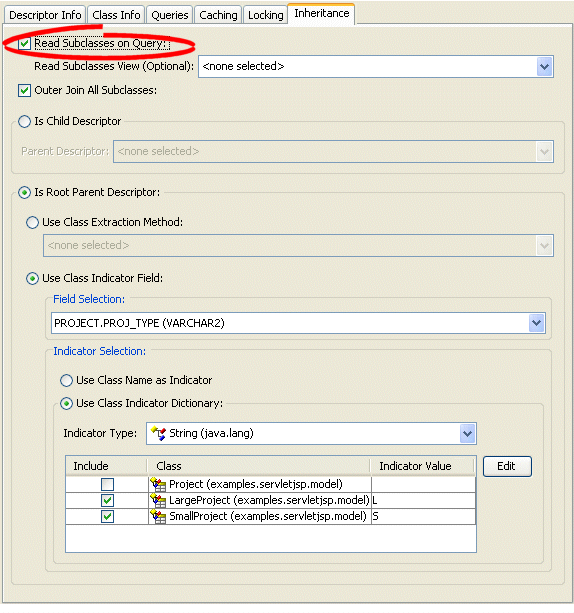
Use the following information to enter data in Read Subclasses on Query and Read Subclasses View fields of the tab:
| Field | Description |
|---|---|
| Read Subclasses on Query | Select this option to configure the root class descriptor to instantiate a subclass when the root class is queried. |
| Read Subclasses View | Optionally select a database view to use for reading subclasses. |
| Outer Join All Subclasses | Optionally use the outerJoinAllSubclsses option to optimize the query. |
Create a descriptor amendment method (Section 119.35, "Configuring Amendment Methods") to customize the root or branch class descriptor's InheritancePolicy.
Example 119-9 shows an amendment method for the Person class. In this example, you use the InheritancePolicy method dontReadSubclassesOnQueries to configure the descriptor so that subclasses are not read on queries.
Example 119-9 Configuring Reading Subclasses on Queries
...
public static void addToPersonDescriptor(Descriptor descriptor) {
descriptor.getInheritancePolicy().dontReadSubclassesOnQueries();
}
...
Example 119-10 shows an amendment method for the Person class. In this example, you use the InheritancePolicy method setReadAllSubclassesViewName to optimize multiple table inheritance queries.
Example 119-10 Configuring Reading Subclasses on Queries Using a View Name
...
public static void addToPersonDescriptor(Descriptor descriptor) {
descriptor.getInheritancePolicy().setReadAllSubclassesViewName(myView);
}
...
Example 119-11 shows an amendment method for the Person class. In this example, you use the InheritancePolicy method setShouldOuterJoinSubclasses to configure the descriptor so that subclasses are outer-joined on queries.
Inheritance describes how a derived (child) class inherits the characteristics of its superclass (parent). When you designate a class as a child, you must also specify the descriptor that represents the child's parent in your inheritance hierarchy.
Table 119-39 summarizes which descriptors support child inheritance configuration.
Table 119-21 Descriptor Support for Child Inheritance Configuration
| Descriptor | How to Use Oracle JDeveloper | How to Configure Inheritance for a Child (Branch or Leaf) Class Descriptor Using TopLink Workbench |
How to Configure Inheritance for a Child (Branch or Leaf) Class Descriptor Using Java |
|---|---|---|---|
|
Relational Descriptors |
|
|
|
|
Object-Relational Data Type Descriptors |
|
|
|
|
EIS Descriptors |
|
|
|
|
XML Descriptors |
|
|
|
For more information about inheritance, see Section 16.2.2, "Descriptors and Inheritance".
For more information about configuring inheritance for a parent (root) class descriptor, see Section 119.21, "Configuring Inheritance for a Parent (Root) Descriptor".
To create a child (branch or leaf class) for an inheritance, use this procedure.
In the Navigator, select the descriptor you wish to specify as a child.
Choose the Inheritance tab in the Property window.
If the Inheritance tab is not visible, right-click the descriptor and choose Select Advanced Properties > Inheritance.
Select the Is Child Descriptor option to specify this descriptor is a child class. The Parent Descriptor list is now enabled and the class indicator information is disabled.
Figure 119-32 Inheritance Tab, Child Descriptor Option
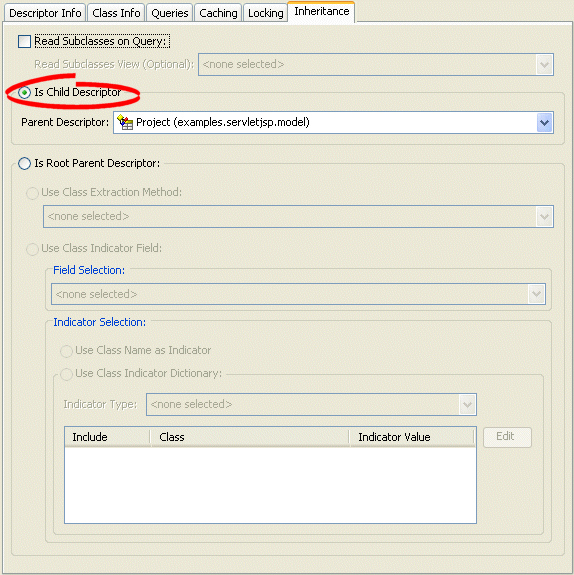
Use the following information to enter data in each child descriptor field on the tab:
| Field | Description |
|---|---|
| Is Child Descriptor | Specify that this descriptor is a child class to be used in a branch or leaf. |
| Parent Descriptor | Use the list to select the parent of this descriptor. See Section 16.2.2, "Descriptors and Inheritance" for more information. |
Using Java, you can configure an inheritance child descriptor using InheritancePolicy method setParentClass, as Example 119-12 shows.
Inheritance describes how a derived (child) class inherits the characteristics of its superclass (parent). When you designate a class as a parent, you can configure how TopLink handles the class's inheritance hierarchy.
Table 119-24 summarizes which descriptors support parent inheritance configuration.
Table 119-22 Descriptor Support for Parent Inheritance Configuration
| Descriptor | How to Use Oracle JDeveloper | How to Configure Inheritance for a Parent (Root) Descriptor Using TopLink Workbench |
How to Configure Inheritance for a Parent (Root) Descriptor Using Java |
|---|---|---|---|
|
Relational Descriptors |
|
|
|
|
Object-Relational Data Type Descriptors |
|
||
|
EIS Descriptors |
|
|
|
|
XML Descriptors |
|
|
|
For more information about configuring inheritance for a child (branch or leaf) class descriptor, see Section 119.20, "Configuring Inheritance for a Child (Branch or Leaf) Class Descriptor".
For more information, see Section 16.2.2, "Descriptors and Inheritance".
To create a root class for an inheritance, use this procedure.
In the Navigator, select the descriptor you wish to specify as the root.
Choose the Inheritance tab in the Property window.
If the Inheritance tab is not visible, right-click the descriptor and choose Select Advanced Properties > Inheritance.
Select the Is Root Parent Descriptor option to specify this descriptor is a root class.
Figure 119-33 Inheritance Tab, Configuring Inheritance for a Root Descriptor
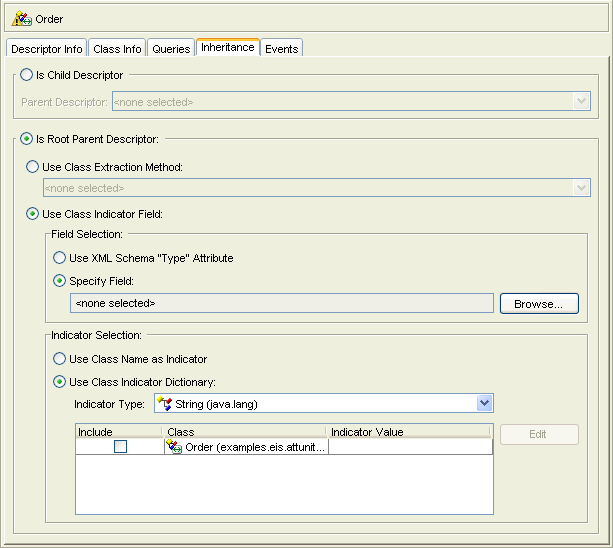
Use this table to complete the following root descriptor field on the Inheritance tab:
| Field | Description |
|---|---|
| Is Root Parent Descriptor | Select this option to specify this descriptor as the root (parent) of the inheritance hierarchy. |
| Use Class Extraction Method | Choose this option to specify a class indicator using a class extraction method, and select your static class extraction method from the list.
For more information, see Section 16.3.1.2, "Using Class Extraction Methods". |
| Use Class Indicator Field | Choose this option to specify a class indicator using a class indicator field.
For more information, see Section 16.3.1.1, "Using Class Indicator Fields". |
| Field Selection | Choose the field to use as the class indicator field. |
| Use XML Schema "Type" AttributeFoot 1 | Select this option to use the type attribute specified in the XML schema for this descriptor's reference class. |
| Specify Field | For a relational descriptor, select the field of the database table associated with this descriptor (see Section 23.2, "Configuring Associated Tables").
For an EIS root descriptor (using XML records) or an XML descriptor, click Browse to select an element attribute or text node. |
| Indicator Selection | Choose between using a class name as the class indicator field value or specifying specific class indicator field values for each (nonabstract) child class. |
| Use Class Name as Indicator | Choose this option to use class names as the class indicator field value. |
| Use Class Indicator Dictionary | Choose this option to specify specific class indicator field values for each (nonabstract) child class.
When you choose this option, you must specify the data type of the class indicator field and the specific class indicator field values for each (nonabstract) child class. |
| Indicator Type | Select the data type from the list to specify the data type of the class indicator field.
To specify the specific class indicator field values for each (nonabstract) child class, click Edit and enter the appropriate value for each child class. |
Footnote 1 EIS root (see Section 75.2.1.1, "EIS Root Descriptors") or XML descriptors (see Section 50.1, "XML Descriptor Concepts") only.
Create a descriptor amendment method (Section 119.35, "Configuring Amendment Methods") to customize the root class descriptor's inheritance policy using InheritancePolicy methods setParentClass, setClassIndicatorFieldName, addClassIndicator, useClassNameAsIndicator and setClassExtractionMethodName, as required.
Example 119-15 shows amendment methods for the Person and Student classes where Student extends Person in a relational project. In this example, a class indicator field is used (see Section 16.3.1.1, "Using Class Indicator Fields").
Example 119-13 Configuring Inheritance for a Relational Root Class
...
public static void addToPersonDescriptor(Descriptor descriptor) {
descriptor.getInheritancePolicy().setClassIndicatorFieldName("CLIENT_TYPE");
descriptor.getInheritancePolicy().addClassIndicator(Student.class, indicator);
}
public static void addToStudentDescriptor(Descriptor descriptor) {
descriptor.getInheritancePolicy().setParentClass(Person.class);
...
}
...
If you are using a class-extraction method (see Section 16.3.1.2, "Using Class Extraction Methods"), you may also need to use InheritancePolicy methods setOnlyInstancesExpression and setWithAllSubclassesExpression (see Section 119.22, "Configuring Inheritance Expressions for a Parent (Root) Class Descriptor").
Example 119-15 shows amendment methods for the Person and Student classes where Student extends Person in an EIS project using XML records. In this example, a class indicator field is used (see Section 16.3.1.1, "Using Class Indicator Fields").
Example 119-14 Configuring Inheritance for an EIS Root Class
...
public static void addToPersonDescriptor(Descriptor descriptor) {
descriptor.getInheritancePolicy().setClassIndicatorField(
new XMLField("@CLIENT_TYPE"));
descriptor.getInheritancePolicy().addClassIndicator(Student.class, indicator);
}
public static void addToStudentDescriptor(Descriptor descriptor) {
descriptor.getInheritancePolicy().setParentClass(Person.class);
descriptor.getInheritancePolicy().setClassIndicatorField(
new XMLField("@CLIENT_TYPE")
);
}
...
If your class uses inheritance (see Section 16.3, "Descriptors and Inheritance") with a class extraction method (see Section 16.3.1.2, "Using Class Extraction Methods") you must provide TopLink with expressions to correctly filter sibling instances for all classes that share a common table.
Table 119-24 summarizes which descriptors support inheritance expression configuration.
Table 119-23 Descriptor Support for Inheritance Expression Configuration
| Descriptor | How to Use Oracle JDeveloper | How to Use TopLink Workbench | How to Configure Inheritance Expressions for a Parent (Root) Class Descriptor Using Java |
|---|---|---|---|
|
Relational Descriptors |
|
||
|
Object-Relational Data Type Descriptors |
|
||
|
EIS Descriptors |
|||
|
XML Descriptors |
Figure 119-34 shows a typical inheritance hierarchy. In this example, instances of both Person and Student are stored in the same PERSON table, as Figure 119-35 shows: an instance of Person has a null value for STUDENT_NUMBER. Instances of Company are stored in a separate COMPANY table.
Figure 119-34 Example Inheritance Hierarchy
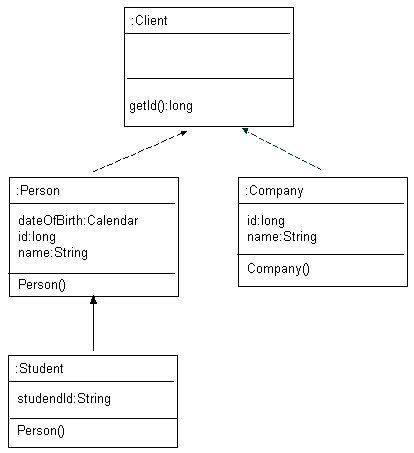
Queries on inheritance classes that share a common table, such as Person and Student, must filter out their sibling instances. TopLink performs this filtering using the Expression instances returned by the descriptor's InheritancePolicy methods getOnlyInstancesExpression and getWithAllSubclassesExpression.
Queries on a class that has its own table for its specific data, such as Company, and does not share this table with any sibling classes, do not require these expressions.
If you use a class indicator type field (see Section 16.3.1.1, "Using Class Indicator Fields"), TopLink automatically generates the required expressions.
If you use a class extraction method (see Section 16.3.1.2, "Using Class Extraction Methods"), you must provide TopLink with an expressions to correctly filter sibling instances for all classes that share a common table.
For concrete classes, you must define an only- instances expression.
For branch classes, you must define a with-all-subclasses expression.
When TopLink queries for a leaf class, it uses the only- instances expression to filter out any sibling classes.
When TopLink queries for a root or branch class whose subclasses do not define their own tables, it uses the with-all-subclasses expression. This is also the case when a subclass view is used (see Section 119.19, "Configuring Reading Subclasses on Queries").
When querying for a root or branch class that has subclasses that span multiple tables, a query is performed for each concrete class in the inheritance hierarchy using the only- instances expression to filter sibling classes.
When a class extraction method is used the only-instances expression is used to determine if a class is concrete. If a class does not require an only instances expression, do not enable reading subclasses on queries (see Section 119.19, "Configuring Reading Subclasses on Queries"), otherwise TopLink will assume that the class has no instances and it will skip that class on queries.
For more information about inheritance expressions, see Section 16.3.1.2.1, "Specifying Expressions for Only-Instances and With-All-Subclasses".
Create a descriptor amendment method (Section 119.35, "Configuring Amendment Methods") to customize the root class descriptor's InheritancePolicy using InheritancePolicy methods setOnlyInstancesExpression and setWithAllSubclassesExpression, as required.
Example 119-15 shows amendment methods for the Person and Student descriptors based on the class hierarchy shown in Figure 119-34 and the database table shown in Figure 119-35.
Example 119-15 Configuring Only-Instances Expressions
... // Only-instances expression for Person public static void addToPersonDescriptor(Descriptor descriptor) { ExpressionBuilder builder = new ExpressionBuilder(); descriptor.getInheritancePolicy().setOnlyInstancesExpression( builder.getField("STUDENT_NUMBER").isNull()); } // Only-instances expression for Student public static void addToStudentDescriptor(Descriptor descriptor) { ExpressionBuilder builder = new ExpressionBuilder(); descriptor.getInheritancePolicy().setOnlyInstancesExpression( builder.getField("STUDENT_NUMBER").notNull()); } ...
Example 119-16 shows amendment methods for the Bicycle and NonFueledVehicle descriptors based on the class hierarchy shown in Figure 16-1 if the vehicle hierarchy stored all of the classes in a single vehicle table, and there was not a class indicator, but a class extraction method instead.
Example 119-16 Configuring Only-Instances and With-All-Subclasses Expressions
// Bicycle amemndment public static void addToBicycleDescriptor(Descriptor descriptor) { ExpressionBuilder builder = new ExpressionBuilder(); descriptor.getInheritancePolicy().setOnlyInstancesExpression( builder.getField("BICYCLE_DESCR").notNull()); } // NonFueldVehicle ammendment public static void addToNonFueledVehicleDescriptor(Descriptor descriptor) { ExpressionBuilder builder = new ExpressionBuilder(); descriptor.getInheritancePolicy().setWithAllSubclassesExpression( builder.getField("FUEL_TYPE").isNull()); }
If you are defining the descriptor for a class that inherits attributes from another class, then you can create mappings for those attributes. If you remap an attribute that was already mapped in the superclass, then the new mapping applies to the subclass only. Any other siblings that inherit the attribute are unaffected.
If you leave inherited attributes unmapped, TopLink uses the mapping (if any) from the superclass if the superclass's descriptor has been designated as the parent descriptor.
Table 119-24 summarizes which descriptors support inherited attribute mapping configuration.
Table 119-24 Descriptor Support for Inherited Attribute Mapping Configuration
| Descriptor | How to Use Oracle JDeveloper | How to Configure Inherited Attribute Mapping in a Subclass Using TopLink Workbench |
How to Configure Inherited Attribute Mapping in a Subclass Using Java |
|---|---|---|---|
|
Relational Descriptors |
|
|
|
|
Object-Relational Data Type Descriptors |
|
||
|
EIS Descriptors |
|
|
|
|
XML Descriptors |
|
|
|
For more information, see Section 16.2.2, "Descriptors and Inheritance".
To map inherited attributes, use this procedure:
In the Navigator, right-click a descriptor and choose Map Inherited Attributes > selected class from the context menu or choose Selected > Map Inherited Attributes from the menu.
The mappings list now includes all the attributes from the superclass of this class.
Map any desired attributes. See Chapter 120, "Creating a Mapping" for more information.
Using Java, attributes inherited by a subclass from a superclass will be visible and you can always create a mapping to these inherited attributes.
You can associate a domain object method with any of the descriptor events shown in Table 119-26. You can register any domain object method that complies with the following criteria:
Is public.
Returns void.
Takes a single parameter of type DescriptorEvent
Table 119-25 summarizes which descriptors support domain object method event handler configuration.
Table 119-25 Descriptor Support for Domain Object Method Event Handler Configuration
| Descriptor | How to Use Oracle JDeveloper | How to Configure a Domain Object Method as an Event Handler Using TopLink Workbench |
How to Configure a Domain Object Method as an Event Handler Using Java |
|---|---|---|---|
|
Relational Descriptors |
|
|
|
|
Object-Relational Data Type Descriptors |
|
||
|
EIS Descriptors |
|
|
|
|
XML Descriptors |
For example, you can add a method handlePostDelete (that is public, returns void, and takes a single parameter of type DescriptorEvent) to your Employee object to handle PostDeleteEvent descriptor events. After you register that method with the DescriptorEventManager owned by the Employee object's descriptor as the handler for PostDeleteEvent descriptor events, whenever the Oracle TopLink runtime performs a post-delete operation on an instance of the Employee object, the runtime dispatches a PostDeleteEvent to the handlePostDelete method on the instance of the Employee object associated with that PostDeleteEvent.
The Descriptor Event ID column in Table 119-26 lists the DescriptorEventManager field name used to identify a particular event. The DescriptorEvent method getEventCode returns this value. For example:
if (descriptorEvent.getEventCode() == DescriptorEventManager.PreUpdateEvent) {
// descriptorEvent represents a pre-update event
}
Table 119-26 Descriptor Events
| Category | Descriptor Event ID | Description |
|---|---|---|
|
Delete |
|
Occurs before an object is deleted from the data source. |
|
|
Occurs when an object is deleted from the data source. |
|
|
|
Occurs after an object is deleted from the data source. |
|
|
Insert |
|
Occurs before an object is inserted in the data source. |
|
|
Occurs when an object is inserted in the data source. |
|
|
|
Occurs after an object is inserted into the data source. |
|
|
Post-X |
|
Occurs after an object is built from the data source. |
|
|
Occurs after an object has been cloned into a unit of work. |
|
|
|
Occurs after an object has been merged from a unit of work. |
|
|
|
Occurs after an object is refreshed from the data source. |
|
|
Update |
|
Occurs before an object is updated in the data source. This may be called in a unit of work even if the object has no changes and does not require updating. |
|
|
Occurs when an object is updated in the data source. This method is called only if the object has changes in the unit of work. |
|
|
|
Occurs after an object is updated in the data source. |
|
|
Write |
|
Occurs before an object is inserted or updated in the data source. This occurs before |
|
|
Occurs after an object is inserted or updated in the data source. This occurs after |
Alternatively, you can configure a descriptor event listener as an event handler (see Section 119.25, "Configuring a Descriptor Event Listener as an Event Handler").
To select event methods, use this procedure:
Select a descriptor in the Navigator. Its properties appear in the Editor.
If the Events advanced property is not visible for the descriptor, then right-click the descriptor and choose Select Advanced Properties > Events from context menu or from the Selected menu.
Click the Event tab in the Editor.
Select the appropriate method category from the list on the left.
Use this table to enter data in the following fields to select the appropriate domain object method:
| Category | Option | Description |
|---|---|---|
| Deleting Methods | Pre | Select the domain object method that is invoked on an instance of its reference class before the instance is deleted from the data source. |
| Post | Select the domain object method that is invoked on an instance of its reference class after the instance is deleted from the data source. | |
| Inserting Methods | Pre | Select the domain object method that is invoked on an instance of its reference class before the instance is inserted in the data source. |
| About To | Select the domain object method that is invoked on an instance of its reference class when the instance is inserted in the data source. | |
| Post | Select the domain object method that is invoked on an instance of its reference class after the instance is inserted into the data source. | |
| Post-X Methods | Build | Select the domain object method that is invoked on an instance of its reference class after the instance is built from the data source. |
| Clone | Select the domain object method that is invoked on an instance of its reference class after the instance is cloned into a unit of work. | |
| Merge | Select the domain object method that is invoked on an instance of its reference class after the instance is merged from a unit of work. | |
| Refresh | Select the domain object method that is invoked on an instance of its reference class after the instance is refreshed from the data source. | |
| Updating Methods | Pre | Select the domain object method that is invoked on an instance of its reference class before the instance is updated in the data source. This may be called in a unit of work even if the object has no changes and does not require updating. |
| About to | Select the domain object method that is invoked on an instance of its reference class when the instance is updated in the data source. This method is called only if the object has changes in the unit of work. | |
| Post | Select the domain object method that is invoked on an instance of its reference class after the instance is updated in the data source. | |
| Writing Methods | Pre | Select the domain object method that is invoked on an instance of its reference class before the instance is inserted or updated in the data source.
Note: This occurs before Pre-Insert and Pre-Update event methods are invoked. |
| Post | Select the domain object method that is invoked on an instance of its reference class after the instance is inserted or updated in the data source.
Note: This occurs after Post-Insert or Post-Update event methods are invoked. |
Example 119-17 shows a domain object class with method handlePostDelete defined to handle PostDeleteEvent descriptor events. Example 119-18 shows how to register this method as the PostDeleteEvent event handler. Whenever the TopLink runtime performs a post-delete operation on an instance of Employee, the runtime will dispatch a PostDeleteEvent to the DescriptorEventManager owned by the Employee object's descriptor. The DescriptorEventManager will then invoke the handlePostDelete method on the instance of Employee associated with that PostDeleteEvent.
You can create your own DescriptorEventListner and register it with a DescriptorEventManager in a descriptor amendment method. You can also configure a DescriptorEventListner to be notified of events through the Java event model.
You can register any object that implements the DescriptorEventListener interface with the DescriptorEventManager owned by a domain object's descriptor to handle any descriptor event type (see Table 119-28). To quickly implement this interface, you can extend abstract class DescriptorEventAdapter and override only the methods for the events you are interested in.
Table 119-27 summarizes which descriptors support descriptor event listener configuration.
Table 119-27 Descriptor Support for Descriptor Event Listener Configuration
| Descriptor | How to Use Oracle JDeveloper | How to Configure a Descriptor Event Listener as an Event Handler Using TopLink Workbench |
How to Configure a Descriptor Event Listener as an Event Handler Using Java |
|---|---|---|---|
|
Relational Descriptors |
|
|
|
|
Object-Relational Data Type Descriptors |
|
||
|
EIS Descriptors |
|
|
|
|
XML Descriptors |
For example, you create a DescriptorEventListener to handle PostBuildEvent descriptor events for Employee objects. After you register this DescriptorEventListener with the DescriptorEventManager owned by the Employee object's descriptor, whenever the TopLink runtime performs a post-build operation on an instance of Employee, the runtime dispatches a PostBuilEvent to the event listener's postBuild method.
Table 119-28 lists the DescriptorEventListener methods associated with each descriptor event. The Descriptor Event Listener Method column lists the DescriptorEventListener methods associated with each DescriptorEvent.
Table 119-28 Descriptor Events
| Category | Descriptor Event Listener Method | Description |
|---|---|---|
|
Delete |
|
Occurs before an object is deleted from the data source. |
|
|
Occurs when an object is deleted from the data source. |
|
|
|
Occurs after an object is deleted from the data source. |
|
|
Insert |
|
Occurs before an object is inserted in the data source. |
|
|
Occurs when an object is inserted in the data source. |
|
|
|
Occurs after an object is inserted into the data source. |
|
|
Post-X |
|
Occurs after an object is built from the data source. |
|
|
Occurs after an object has been cloned into a unit of work. |
|
|
|
Occurs after an object has been merged from a unit of work. |
|
|
|
Occurs after an object is refreshed from the data source. |
|
|
Update |
|
Occurs before an object is updated in the data source. This may be called in a unit of work even if the object has no changes and does not require updating. |
|
|
Occurs when an object is updated in the data source. This method is called only if the object has changes in the unit of work. |
|
|
|
Occurs after an object is updated in the data source. |
|
|
Write |
|
Occurs before an object is inserted or updated in the data source. This occurs before |
|
|
Occurs after an object is inserted or updated in the data source. This occurs after |
Alternatively, you can configure a domain object method as an event handler (see Section 119.24, "Configuring a Domain Object Method as an Event Handler").
For more information, see Section 119.24.1, "How to Configure a Domain Object Method as an Event Handler Using TopLink Workbench".
Example 119-19 shows a DescriptorEventListener that handles PostBuildEvent descriptor events. Example 119-20 shows how to register this DescriptorEventListener with the Employee object's descriptor. Whenever the TopLink runtime performs a post-build operation on an instance of Employee, the runtime will dispatch a post build event to the corresponding DescriptorEventListener method on each registered event listener (in this case, it calls the postBuild method).
You can configure a descriptor with a locking policy that prevents one user writing over another user's work.
Table 119-29 summarizes which descriptors support locking policies.
Table 119-29 Descriptor Support for Locking Policy
| Descriptor | Optimistic Version Locking Policies |
Optimistic Field Locking Policies |
Pessimistic Locking Policy |
How to Use Oracle JDeveloper | How to Configure Locking Policy UsingTopLink Workbench |
How to Configure Locking Policy Using Java |
|---|---|---|---|---|---|---|
|
Relational DescriptorsFoot 1 |
|
|
|
|
|
|
|
Object-Relational Data Type Descriptors |
|
|
|
|
|
|
|
EIS DescriptorsFoot 2 |
|
|
|
|
|
|
|
XML Descriptors |
|
|
|
|
|
|
Footnote 1 Relational class descriptors only (see Section 22.2.1.1, "Creating Relational Class Descriptors").
Footnote 2 EIS root descriptors only (see Section 75.2.1.1, "EIS Root Descriptors").
Oracle recommends that you use a locking policy. You should use a locking policy in any multiuser environment to prevent one user writing over another user's changes. Although locking can be particularly important if multiple servers or multiple applications access the same data, even in a single server application, the same locking issue still exists. In a multiple-server environment, locking is still relevant even if your application uses cache refreshing or cache coordination.
If you are building a three-tier application, in order to correctly lock an object, you must obtain the lock before the object is sent to client to be edited. The type of locking you choose has an influence on how you can achieve this (see Section 16.4.6, "Locking in a Three-Tier Application").
To specify a descriptor's locking policy, use this procedure:
In the Navigator, select a relational or EIS root descriptor.
If the Locking advanced property is not visible for the descriptor, right-click the descriptor and choose Select Advanced Properties > Locking from the context menu or from the Selected menu.
Click the Locking tab.
Figure 119-37 Locking Tab for a Descriptor
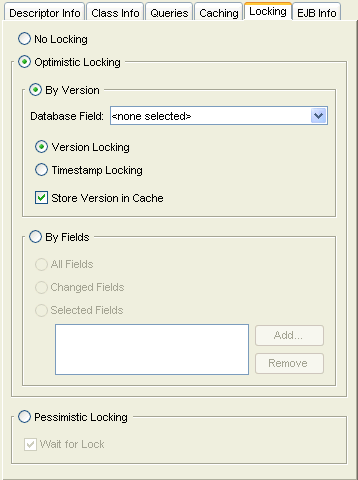
Figure 119-38 Locking Tab for an EIS Root Descriptor
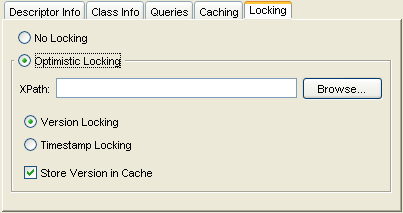
Use this table to enter data in the following fields on the tab of the appropriate type:
| Field | Description |
|---|---|
| Optimistic Locking | Specify that the descriptor uses optimistic locking. |
| By Version | Specify to use optimistic locking, based on versioning. |
| Database Field | Select the database field that contains the version value used for optimistic locking.
This field appears for relational descriptors only. |
| XPath | Click Browse to define the path to the element or attribute that stores the version value.
This field appears for EIS root descriptors only. Ensure that the attribute's type corresponds to the type of locking policy you choose ( |
| Version Locking | Specify that the descriptor uses numeric version locking. The version field (defined by the Database Field, for relational descriptors, or the XPath, for EIS root descriptors) must be a numeric type |
| Timestamp Locking | Specify that the descriptor uses time stamp version locking, based on time stamp. The version field (defined by the Database Field, for relational descriptors, or the XPath, for EIS root descriptors) must be a timestamp type. |
| Store Version in Cache | Specify whether or not you want to store the version information in the cache.
If you choose not to define a mapping for the version field, then you must enable this option to configure the descriptor to store the version value in the Oracle TopLink cache. If you choose to define a mapping for the version field, then you must disable this option in order to store the version value in the object. For more information, see Section 16.4.6.1, "Optimistic Locking in a Three-Tier Application". |
| By FieldsFoot 1 | Specify to use optimistic locking, based on database fields.
These fields appear for relational descriptors only. |
| All Fields | Select all fields for optimistic locking. |
| Changed Fields | Select only the changed fields for optimistic locking. |
| Selected Fields | Click Add to select specific database fields for optimistic locking. |
| Pessimistic Locking | Specify to use pessimistic locking for this descriptor.
This applies only to descriptors that have had EJB CMP information configured for them (see Section 119.18, "Configuring a Descriptor with EJB CMP and BMP Information"). |
| Wait for Lock | Specify whether or not TopLink should wait for a data source lock. When not selected, the thread of execution will immediately throw a DatabaseException if it cannot acquire a read lock on the object.
When selected, the thread of execution will wait indefinitely until the read lock is released, at which time, it will attempt to acquire it. Use this option with care as it can lead to application deadlocks. |
Footnote 1 You cannot use field locking with the AttributeChangeTrackingPolicy (see Section 113.2.3.3, "Attribute Change Tracking Policy").
This section describes the following:
Use the ClassDescriptor method setOptimisticLockingPolicy to set an instance of the appropriate optimistic field locking policy:
AllFieldsLockingPolicy
ChangedFieldsLockingPolicy
SelectedFieldsLockingPolicy
VersionLockingPolicy
TimestampLockingPolicy
Use the ClassDescriptor method getOptimisticLockingPolicy to get the selected locking policy type and configure it.
If you are using a VersionLockingPolicy, you can enable cascading to configure TopLink to automatically force a version field update on a parent object when its privately owned child object's version field changes. Use VersionLockingPolicy method setIsCascaded passing in a boolean of true to enable cascading, or false to disable cascading.
For more information, see Section 16.4.2, "Optimistic Version Locking Policies and Cascading".
You can configure a descriptor with a PessimisticLockingPolicy only when using a CMPPolicy. That is, you only can configure a PessimisticLockingPolicy for descriptors that support EJB CMP information (see Section 119.18, "Configuring a Descriptor with EJB CMP and BMP Information") in a CMP project.
Instantiate a CMPPolicy and use CMPPolicy method setPessimisticLockingPolicy to set an instance of PessimisticLockingPolicy. Then use the ClassDescriptor method setCMPPolicy to set the CMPPolicy.
Using a ReturningPolicy, you can obtain field values from the data source when inserting or updating an object. TopLink uses the values that the data source returns to update the object attributes that map to these fields. You can specify which fields to return for inserts and updates. For insert fields, you can also specify whether or not to include the field value in the insert operation.
A ReturningPolicy is useful when the data source provides default or initial field values through defaults, triggers, or stored procedures. You can also use a ReturningPolicy to allow the data source to assign a sequence or primary key value.
Any object attribute that you do not configure in a descriptor's ReturningPolicy receives the default behavior: in the context of a unit of work, if the attribute has changed, its value is written to the database. If the SQL statement invokes a trigger or stored procedure that modifies the database field, the database generated value is not reflected by the object.
Use caution when deciding on whether or not to use a ReturningPolicy, as doing so may effect insert or update performance and is not compatible with batch writing (see Section 12.11.3, "How to Use Batch Writing for Optimization").
By default, you can use a ReturningPolicy with Oracle Database, in which case, TopLink uses the Oracle RETURNING clause (see Section 119.27.1, "How to Configure Returning Policy Using TopLink Workbench").
You can use a ReturningPolicy with a non-Oracle database if you configure your descriptor's insert or update query to use a stored procedure that returns the desired returned values as output parameters (see Section 119.27.2, "How to Configure Returning Policy Using Java").
Table 119-39 summarizes which descriptors support returning policy configuration.
Table 119-30 Descriptor Support for Fetch Group Configuration
| Descriptor | How to Use Oracle JDeveloper | How to Configure Returning Policy Using TopLink Workbench |
How to Configure Returning Policy Using Java |
|---|---|---|---|
|
Relational Descriptors |
|
|
|
|
Object-Relational Data Type Descriptors |
|
||
|
EIS DescriptorsFoot 1 |
|
|
|
|
XML Descriptors |
Footnote 1 EIS root descriptors only (see Section 75.2.1.1, "EIS Root Descriptors").
To specify the return policy for a descriptor, use this procedure:
Select a descriptor in the Navigator. Its properties appear in the Editor.
If the Returning advanced property is not visible for the descriptor, right-click the descriptor and choose Select Advanced Properties > Returning from the context menu or from the Selected menu.
Click the Returning tab in the Editor.
Use the following information to enter data in each field on the tab:
| Field | Description |
|---|---|
| Insert | These options apply to insert operations: |
| Name | Click Add to add a database field to this ReturningPolicy for insert operations. |
| ReturnEonly | When selected, TopLink only returns a value for this field; it will not include the field in the insert.
When not selected, TopLink returns a value for this field and includes the value in the insert. |
| Update | These options apply to update operations: |
| Name | Click Add to add a database field to this ReturningPolicy for update operations |
To remove a database field from the descriptor's ReturningPolicy, select the field in the Insert or Update window and click Remove.
Note:
If you are using TopLink Workbench, you cannot configure a returning policy for an attribute mapped with a transformation mapping (see Section 27.13, "Transformation Mapping").You use a ReturningPolicy to configure how TopLink handles returning with the attributes of an object on a field-by-field basis. Table 119-31 describes the ReturnPolicy methods you use to tell TopLink how to handle a particular database field. Each method takes a String or a DatabaseField type parameter as field name.
Table 119-31 Return Policy Methods
| Method | Applies to SQL Statements of Type... | Writes Current Value of Field to Database? | Returns Database- Generated Result? |
|---|---|---|---|
|
|
INSERT |
Yes |
Yes |
|
|
INSERT |
No |
Yes |
|
|
UPDATE |
Yes |
Yes |
You configure a descriptor with a ReturningPolicy using ClassDescriptor method setReturningPolicy.
The TopLink runtime instantiates new instances of a class according to the instantiation policy you configure on the class's descriptor.
Table 119-32 summarizes which descriptors support an instantiation policy.
Table 119-32 Descriptor Support for Instantiation Policy
| Descriptor | How to Use Oracle JDeveloper | How to Configure Instantiation Policy Using TopLink Workbench |
How to Configure Instantiation Policy Using Java |
|---|---|---|---|
|
Relational Descriptors |
|
|
|
|
Object-Relational Data Type Descriptors |
|
|
|
|
EIS Descriptors |
|
|
|
|
XML Descriptors |
|
|
|
You can specify one of the following types of instantiation policy:
Default: TopLink creates a new instance of a class by calling the class's default constructor.
Method: TopLink creates a new instance of a class by calling a public static method that you define on the class descriptor.
Factory: TopLink creates a new instance of a class by calling the appropriate methods on a separate class that you implement according to the Factory design pattern.
To set the instantiation policy for a descriptor, use this procedure:
In the Navigator, select a descriptor.
If the Instantiation advanced property is not visible for the descriptor, right-click the descriptor and choose Select Advanced Properties > Instantiation from the context menu or from the Selected menu.
Use the following information to enter data in each field on the tab:
| Field | Description |
|---|---|
| Use Default Constructor | Specify if the default constructor of the class instantiates a new instance. |
| Use Method | Specify a method to execute to create objects from the database. |
|
Select the name of a method to be executed to create objects from the database. The method must be a public, static method on the descriptor's class and must return a new instance of the object. |
| Use Factory | Specify an object factory method. |
| Factory Class | Select the class of the factory object that creates the new instances. |
| Factory Method | Select the method to be used to obtain a factory object. Choose <nothing> to use the default constructor. |
| Instantiation Method | Select the method to be called on the factory object to obtain a new instance that will be populated with data from the data source. |
Use one of the following ClassDescriptor methods to set the appropriate type of instantiation policy:
useDefaultConstructorInstantiationPolicy
useMethodInstantiationPolicy
useFactoryInstantiationPolicy
The TopLink unit of work feature must be able to produce an exact copy (clone) persistent objects. Table 119-33 summarizes which descriptors support a copy policy.
Table 119-33 Configuring Descriptors with a Copy Policy
| Descriptor | How to Use Oracle JDeveloper | How to Configure Copy Policy Using TopLink Workbench |
How to Configure Copy Policy Using Java |
|---|---|---|---|
|
Relational Descriptors |
|
|
|
|
Object-Relational Data Type Descriptors |
|
|
|
|
EIS Descriptors |
|
|
|
|
XML Descriptors |
|
|
|
TopLink supports the following two ways of copying objects:
Instantiation policy: By default, TopLink creates a new copy of an object by using the currently configured instantiation policy (see Section 119.28, "Configuring Instantiation Policy").
Method: TopLink creates a new copy of an object by calling a method on the object that you specify. For example, you can specify the object's clone method (or any other appropriate method on the object). Note that the clone method should return a shallow clone of the object.
To specify the copy policy for a descriptor, use this procedure:
Select a descriptor in the Navigator. Its properties appear in the Editor.
If the Copying advanced property is not visible for the descriptor, right-click the descriptor and choose Select Advanced Properties > Copying from the context menu or from the Selected menu.
Click the Copying tab in the Editor.
Use the following information to enter data in each field on the tab:
| Field | Description |
|---|---|
| Use Instantiation Policy | Creates a new instance of the object using the descriptor's instantiation policy (see Section 119.28, "Configuring Instantiation Policy"). |
| Use Clone Method | Specifies whether or not to call the clone method of the object. Select a method from the list. |
Use one of the following ClassDescriptor methods to set the appropriate type of copy policy:
useCloneCopyPolicy(): the object must provide a clone method
useCloneCopyPolicy(java.lang.String cloneMethodName)
useInstantiationCopyPolicy()
Use a change policy to specify how TopLink should track changes made to objects after you register them with a unit of work. Table 119-34 summarizes which descriptors support a change policy.
Table 119-34 Descriptor Support for Change Policy
| Descriptor | Deferred Change Detection Policy |
Object-Level Change Tracking Policy |
Attribute Change Tracking Policy |
How to Use Oracle JDeveloper | How to Use TopLink Workbench | How to Configure Change Policy Using Java |
|---|---|---|---|---|---|---|
|
Relational DescriptorsFoot 1 |
|
|
|
|
||
|
Object-Relational Data Type Descriptors |
|
|
|
|
||
|
EIS DescriptorsFoot 2 |
|
|
|
|
||
|
XML Descriptors |
Footnote 1 Relational class descriptors only (see Section 22.2.1.1, "Creating Relational Class Descriptors").
Footnote 2 EIS root descriptors only (see Section 75.2.1.1, "EIS Root Descriptors").
By default, TopLink uses the deferred change detection policy.
For JPA entities or POJO classes that you configure for weaving, TopLink weaves value holder indirection for one-to-one mappings. If you want TopLink to weave change tracking and your application includes collection mappings (one-to-many or many-to-many), then you must configure all collection mappings to use transparent indirect container indirection only (you may not configure your collection mappings to use eager loading nor value holder indirection).
Mutable basic mappings affect the overhead of change tracking. TopLink can only weave an attribute change tracking policy for immutable mappings.
TopLink logs a warning message at the CONFIG log level if you try to weave a descriptor that does not support change policy.
TopLink supports alternative change policies (policies other than DeferredChangeDetectionPolicy) for attributes that use a subset of the mappings that TopLink supports.
For CMP and JPA applications deployed to OC4J TopLink automatically uses the attribute change tracking policy.
For more information, see the following:
"Using EclipseLink JPA Weaving" section of EclipseLink Developer's Guide at http://wiki.eclipse.org/Using_EclipseLink_JPA_Extensions_%28ELUG%29#Using_EclipseLink_JPA_Weaving
This section describes how to configure a descriptor with a change policy using Java, and how to implement persistent classes for those change policies that are intrusive. It includes information on configuring the following:
The DeferredChangeDetectionPolicy provides good unit of work commit performance for a wide range of object change characteristics. It is the default change policy. For more information, see Section 113.2.3.1, "Deferred Change Detection Policy").
Because it is the default, you do not need to explicitly configure this policy.
To configure TopLink to use a DeferredChangeDetectionPolicy, create a descriptor amendment method (see Section 119.35, "Configuring Amendment Methods") that sets the change policy, as Example 119-21 illustrates.
The ObjectChangeTrackingPolicy provides improved unit of work commit performance for objects with few attributes, or with many attributes and many changed attributes. For more information, see Section 113.2.3.2, "Object-Level Change Tracking Policy").
For CMP and JPA applications deployed to an application server, for which TopLink provides CMP integration (see Section 8.1, "Introduction to the Application Server Support"), when you configure an entity bean's descriptor with an ObjectLevelChangeTrackingPolicy, TopLink automatically generates code of a concrete subclass to implement the TopLink ChangeTracker interface at deploy time. Configuring an ObjectLevelChangeTrackingPolicy prevents TopLink from automatically applying an AttributeChangeTrackingPolicy (see Section 119.30.1.3, "Configuring Attribute Change Tracking Policy").
To configure TopLink to use an ObjectChangeTrackingPolicy, use this procedure:
Create a descriptor amendment method (see Section 119.35, "Configuring Amendment Methods") that sets the change policy, as Example 119-21 illustrates.
For plain Java objects, code each of your persistent classes to implement the ChangeTracker interface, as Example 119-22 illustrates.
Example 119-22 Implementing the ChangeTracker Interface for the ObjectChangeTrackingPolicy
public class Employee implements ChangeTracker {
PropertyChangeListener listener;
String firstName;
public PropertyChangeListener getTopLinkPropertyChangeListener() {
return this.listener;
}
public void setTopLinkPropertyChangeListener(PropertyChangeListener listener) {
this.listener = listener;
}
...
public void setFirstName(String firstName) {
propertyChange("firstName", getFirstName(), firstName);
this.firstName = firstName;
}
...
public void propertyChange(String propertyName, Object oldValue, Object newValue) {
if (listener != null) {
if (oldValue != newValue) {
listener.propertyChange(
new PropertyChangeEvent(this, propertyName, oldValue, newValue));
}
}
}
}
The AttributeChangeTrackingPolicy provides improved unit of work commit performance for objects with many attributes and few changed attributes. In general, this is the most efficient change policy. It is the default change policy for JPA and EJB 2.n CMP applications deployed to OC4J. For more information, see Section 113.2.3.3, "Attribute Change Tracking Policy").
Note:
You cannot use theAttributeChangeTrackingPolicy if you are using any instance of FieldsLockingPolicy (see Section 16.4.4, "Optimistic Field Locking Policies").When you deploy a TopLink-enabled EJB 3.0 persistent application or EJB 2.n CMP application to OC4J, TopLink automatically configures your persistent classes to use the AttributeChangeTrackingPolicy and, using bytecode weaving (EJB 3.0) or code generation (EJB 2.n), configures your persistence classes to implement the TopLink ChangeTracker interface. In this case, you do not need to explicitly configure this change policy.
To configure TopLink to use an AttributeChangeTrackingPolicy for plain Java objects or other application servers, use this procedure:
Create a descriptor amendment method (see Section 119.35, "Configuring Amendment Methods") that sets the change policy as Example 119-23 illustrates.
Code each of your persistent classes to implement the ChangeTracker interface, as Example 119-24 illustrates.
Example 119-24 Implementing the ChangeTracker Interface for the AttributeChangeTrackingPolicy
public class Employee implements ChangeTracker {
PropertyChangeListener listener;
String firstName;
public PropertyChangeListener getTopLinkPropertyChangeListener() {
return this.listener;
}
public void setTopLinkPropertyChangeListener(PropertyChangeListener listener) {
this.listener = listener;
}
...
public void setFirstName(String firstName) {
propertyChange("firstName", getFirstName(), firstName);
this.firstName = firstName;
}
...
public void propertyChange(String propertyName, Object oldValue, Object newValue) {
if (listener != null) {
if (oldValue != newValue) {
listener.propertyChange(
new PropertyChangeEvent(this, propertyName, oldValue, newValue));
}
}
}
}
If you want to use historical sessions (see Section 87.6, "Historical Sessions") to execute historical queries (see Section 108.11, "Historical Queries") against a historical schema of your own design, configure your descriptors with a TopLink HistoryPolicy that describes your historical schema.
If you are using Oracle Database platform for Oracle9i Database (or later), you can query the historical versions of objects automatically maintained by Oracle Database without the need for a history policy. For more information, see Section 93.1.1, "How to Configure Historical Sessions Using an Oracle Platform".
Table 119-35 summarizes which descriptors support history policy configuration.
Table 119-35 Descriptor Support for History Policy Configuration
| Descriptor | How to Use Oracle JDeveloper | How to Use TopLink Workbench | How to Configure a History Policy Using Java |
|---|---|---|---|
|
Relational Descriptors |
|
||
|
Object-Relational Data Type Descriptors |
|
||
|
EIS Descriptors |
|||
|
XML Descriptors |
There are many ways to configure a historical database schema. TopLink supports several historical schema configurations that you can describe with a HistoryPolicy (see Section 87.6.1, "Historical Session Limitations").
Example Historical Schema
As shown in Table 119-36 and Table 119-37, a common approach is to define a special history table to store past versions of an object: one history table for each regular table that requires historical persistence. The history table typically has the same fields as the corresponding regular table plus fields (such as row start and end) used to define an interval that represents the life time of a particular version.
Note:
TopLink assumes that the current version of an object corresponds to the historical table row whose row end field isNULL.TopLink will include the history tables described by a HistoryPolicy when you execute a historical query.
Table 119-36 shows the schema for an EMPLOYEE table. The table currently contains one EMPLOYEE instance.
Table 119-37 shows one possible history table EMPLOYEE_HIST that stores historical versions of employees. The table contains the current EMPLOYEE (the version with a ROW_END value of NULL) and one historical version.
Table 119-37 Example History Table EMPLOYEE_HIST
| EMP_ID | F_NAME | L_NAME | SALARY | ROW_START | ROW_END |
|---|---|---|---|---|---|
|
1 |
Jane |
Doe |
50000 |
29/08/2004 |
31/08/2004 |
|
1 |
Jane |
Doe |
55000 |
31/08/2004 |
NULL |
Because every record has a start and end interval, the history table can store multiple versions of the same object (with the same primary key). The unique identifier of a particular version is given by the existing primary key, plus the value of the start field. For example, in Table 119-37, the unique identifier of the current version is given by (EMP_ID, START) = (1, 31/08/2004).
Example 119-25 shows how to describe the schema shown in Table 119-36 and Table 119-37 using the TopLink HistoryPolicy:
Example 119-25 HistoryPolicy for One Table
HistoryPolicy policy = new HistoryPolicy();
policy.addStartFieldName("ROW_START");
policy.addEndFieldName("ROW_END");
policy.addHistoryTableName("EMPLOYEE", "EMPLOYEE_HIST");
// Assuming database triggers or stored procedures update history tables
policy.setShouldHandleWrites(false);
employeeDescriptor.setHistoryPolicy(policy);
You can specify more than one table with a HistoryPolicy as shown in Example 119-26. In this example, all history tables have a start field named ROW_START but the EMPLOYEE_HIST and SALARY_HIST tables have different end fields. To avoid ambiguity, the end field names are prefixed with their respective history table names.
Example 119-26 HistoryPolicy for Multiple Tables
HistoryPolicy policy = new HistoryPolicy();
policy.addStartFieldName("ROW_START");
policy.addEndFieldName("EMPLOYEE_HIST.ROW_END");
policy.addEndFieldName("SALARY_HIST.VALID_UNTIL");
policy.addHistoryTableName("EMPLOYEE", "EMPLOYEE_HIST");
policy.addHistoryTableName("SALARY", "SALARY_HIST");
// Assuming database triggers or stored procedures update history tables
policy.setShouldHandleWrites(false);
employeeDescriptor.setHistoryPolicy(policy);
Use HistoryPolicy method setShouldHandleWrites to specify whether or not TopLink is responsible for writing data to history tables. By default, setShouldHandleWrites is set to true.
Either the database or TopLink can be responsible for writing data to the history tables.
You can configure the database to write data to history tables by way of triggers or stored procedures that customize create, insert, and delete operations to modify both the regular table and the history table appropriately.
TopLink lets you use wrappers (or proxies) in cases where the persistent class is not the same class that is to be presented to users.
For example, in the EJB specification prior to 3.0, the entity bean class (the class that implements javax.ejb.EntityBean) is persistent, but is hidden from users who interact with a class that implements javax.ejb.EJBObject (local or remote interface class). In this example, the EJBObject acts as a proxy (or wrapper) for the EntityBean.
In cases where such a wrapper is used, TopLink continues to make the class specified in the descriptor persistent, but returns the appropriate instance of the wrapper whenever a persistent object is requested.
Table 119-38 summarizes which descriptors support a wrapper policy.
Table 119-38 Descriptor Support for Wrapper Policy
| Descriptor | How to Use Oracle JDeveloper | How to Use TopLink Workbench | How to Configure Wrapper Policy Using Java |
|---|---|---|---|
|
Relational Descriptors |
|
||
|
Object-Relational Data Type Descriptors |
|
||
|
EIS Descriptors |
|
||
|
XML Descriptors |
Use a wrapper policy to tell TopLink how to create wrappers for a particular persistent class, and how to obtain the underlying persistent object from a given wrapper instance.
If you specify a wrapper policy, TopLink uses the policy to wrap and unwrap persistent objects as required:
Wrapper policies implement the interface oracle.toplink.descriptors.WrapperPolicy.
A wrapper policy is specified by setting the wrapper policy for the TopLink descriptor.
By default, no wrapper policy is used (the wrapper policy for a descriptor is null by default).
Note:
Wrapper policies are advanced TopLink options. Using a wrapper policy may not be compatible with some TopLink Workbench features.For CMP descriptors, the EJB wrapper policy is automatically configured during deployment, so does not need to be set in the descriptor (see Section 119.18, "Configuring a Descriptor with EJB CMP and BMP Information").
For BMP descriptors, you must set a BMPWrapperPolicy on the descriptor. The BMPWrapperPolicy includes the bean's information including the bean-name, primary-key-class, home-interface, and remote-interface.
Wrapper policies cannot be set using Oracle JDeveloper or TopLink Workbench and can be set only using Java code (see Section 119.32.1, "How to Configure Wrapper Policy Using Java").
Use the ClassDescriptor method setWrapperPolicy to set the appropriate instance of WrapperPolicy.
Example 119-27 shows how to amend a BMP descriptor with the required BMP information.
By default, when you execute an object-level read query for a particular object class, TopLink returns all the persistent attributes mapped in the object's descriptor. With this single query, all the object's persistent attributes are defined, and calling their get methods returns the value directly from the object.
When you are interested in only some of the attributes of an object, it may be more efficient to return only a subset of the object's attributes using a fetch group.
Using a fetch group, you can define a subset of an object's attributes and associate the fetch group with either a ReadObjectQuery or ReadAllQuery query. When you execute the query, TopLink retrieves only the attributes in the fetch group. TopLink automatically executes a query to fetch all the attributes excluded from this subset when and if you call a get method on any one of the excluded attributes.
You can define more than one fetch group for a class. You can optionally designate at most one such fetch group as the default fetch group. If you execute either a ReadObjectQuery or ReadAllQuery query without specifying a fetch group, TopLink will use the default fetch group, unless you configure the query otherwise (see Section 111.3.1, "How to Configure Default Fetch Group Behavior").
You can use fetch groups in CMP or JPA projects for EJB objects, as well as for POJO classes.
Before using fetch groups, Oracle recommends that you perform a careful analysis of system use. In many cases, the extra queries required to load attributes not in the fetch group could well offset the gain from the partial attribute loading. For more information about optimizing read performance, see Section 12.12.9, "Read Optimization Examples".
Table 119-39 summarizes which descriptors support fetch group configuration.
Table 119-39 Descriptor Support for Fetch Group Configuration
| Descriptor | How to Use Oracle JDeveloper | How to Use TopLink Workbench | How to Configure Fetch Groups Using Java |
|---|---|---|---|
|
Relational Descriptors |
|
||
|
Object-Relational Data Type Descriptors |
|
||
|
EIS Descriptors |
|||
|
XML Descriptors |
For JPA entities or POJO classes that you configure for weaving, TopLink uses fetch groups to improve performance.
This section describes how to create a fetch group, store it in a descriptor, and optionally designate a fetch group as the default fetch group for its descriptor reference class.
For more information, see the following:
Section 108.7.1.6, "Fetch Groups and Object-Level Read Queries"
Section 111.3.1, "How to Configure Default Fetch Group Behavior"
"Using EclipseLink JPA Weaving" section of EclipseLink Developer's Guide at http://wiki.eclipse.org/Using_EclipseLink_JPA_Extensions_%28ELUG%29#Using_EclipseLink_JPA_Weaving
To configure a fetch group, use a descriptor amendment method (see Section 119.35, "Configuring Amendment Methods") as Example 119-28 shows.
Example 119-28 Configuring a Fetch Group
//Create a FetchGroupManager for the descriptor descriptor.setFetchGroupManager(new FetchGroupManager()); // Create a FetchGroup FetchGroup group = new FetchGroup("nameOnly"); // Add attributes to FetchGroup. Alternatively, use // FetchGroup method addAttributes, passing in a Set of String attribute names group.addAttribute("firstName"); group.addAttribute("lastName"); // Add the FetchGroup to the FetchGroupManager descriptor.getFetchGroupManager().addFetchGroup(group); //Set the default fetch group descriptor.getFetchGroupManager().setDefaultFetchGroup(group);
Each instance of FetchGroup that you store in a descriptor must be configured with a fetch group name that is unique for that descriptor (that is, each descriptor owns a set of named fetch groups).
When configuring fetch groups, note that the primary key fields and other required fields (such as inheritance type and optimistic lock version) are always included in all fetch groups.Fetch groups can include direct and relationship attributes. Including a relationship attribute in a fetch group does not cause the relationship to be joined or instantiated: joining and indirection are set independently of fetch groups.
After you add a fetch group to a descriptor, you can configure a ReadObjectQuery or ReadAllQuery query with this fetch group by name (nameOnly) or rely on TopLink to use this fetch group by default. For more information, see Section 111.3, "Using Queries with Fetch Groups".
A descriptor customizer class is a Java class that implements the oracle.toplink.tools.sessionconfiguration.DescriptorCustomizer interface and provides a default (zero-argument) constructor. You can use a descriptor customizer to customize a descriptor at run time on a loaded session before login occurs, similar to how you can use an amendment method (see Section 119.35, "Configuring Amendment Methods").
Table 119-40 summarizes which sessions support customizer class configuration.
Table 119-40 Descriptor Support for Customizer Class Configuration
| Descriptor | How to Use Oracle JDeveloper | How to Use TopLink Workbench | How to Configure Customizer Class Using Java |
|---|---|---|---|
|
Relational Descriptors |
|
|
|
|
Object-Relational Data Type Descriptors |
|
|
|
|
EIS Descriptors |
|
|
|
|
XML Descriptors |
|
|
For more information, see Section 16.2.6, "Descriptor Customization".
When using Java, create a customize class that implements the oracle.toplink.tools.sessionconfiguration.DescriptorCustomizer interface. Example 119-29 illustrates the creation of a descriptor customizer.
Example 119-29 Creating a SessionCustomizer Class
import oracle.toplink.tools.sessionconfiguration.DescriptorCustomizer;
import oracle.toplink.descriptors.ClassDescriptor;
public class EmployeeDescriptorCustomizer implements DescriptorCustomizer {
public void customize(ClassDescriptor descriptor) {
descriptor.setReadOnly();
}
}
Some TopLink descriptor features cannot be configured from Oracle JDeveloper or TopLink Workbench. To use these features, you must write a Java method to amend the descriptor after it is loaded as part of the project. This method must have the following characteristics:
Be public static.
Take a single parameter of type oracle.toplink.descriptors.ClassDescriptor.
In the implementation of this method, you can configure advanced features of the descriptor using any of the public descriptor and mapping API.
Table 119-41 summarizes which descriptors support amendment methods.
Table 119-41 Descriptor Support for Amendment Methods
| Descriptor | How to Use Oracle JDeveloper | How to Configure Amendment Methods Using TopLink Workbench |
How to Use Java |
|---|---|---|---|
|
Relational Descriptors |
|
|
|
|
Object-Relational Data Type Descriptors |
|||
|
EIS Descriptors |
|
|
|
|
XML Descriptors |
|
|
This section describes how to associate an amendment method with a descriptor.
For more information about how to implement an amendment method, see Section 16.2.7, "Amendment and After-Load Methods".
Alternatively, you can use a descriptor customizer class (see Section 119.34, "Configuring a Descriptor Customizer Class"
To customize a session, use a session customizer class (see Section 89.8, "Configuring a Session Customizer Class").
To use an amendment method with a descriptor (after it is loaded as part of the project) use this procedure:
Select a descriptor in the Navigator. Its properties appear in the Editor.
If the After load advanced property is not visible for the descriptor, right-click the descriptor and choose Select Advanced Properties > After Load from context menu or from the Selected menu.
| Field | Description |
|---|---|
| Class | Click Browse and choose the class of the method to execute. |
| Static Method | Use the Static Method list to choose the static method to execute at run time, after loading the descriptor. The method must be public static and take a single attribute of type oracle.toplink.descriptors.ClassDescriptor. |